The IFV that started it all
The BMP-1 from the BMP family (which stands for Boyevaya Mashina or literally "Infantry Fighting Vehicle") is certainly one of the most famous IFV worldwide, creating a stir in the West when it appeared. It was to enter service in 1966, thus, the title of "first" could be easily challenged by the West German SPZ Kürz (1958) and the SPZ Lang. Both could carry a few Panzergrenadiers and were armed with a 20 mm autocannon. However, both their fighting capabilities and carrying abilities were quite limited, which makes the Soviet design superior in many ways but moreover much more widespread. Indeed as both German IFVs were only used in Germany, the BMP-1 was produced, directly or indirectly until the 1980s to an extent of 20,000 vehicles and 64 countries had it (or still have it) in service. Also, the BMP saw more action than any other IFV of the past century, together with the BMP-2, now both replaced by the Russian-era BMP-3.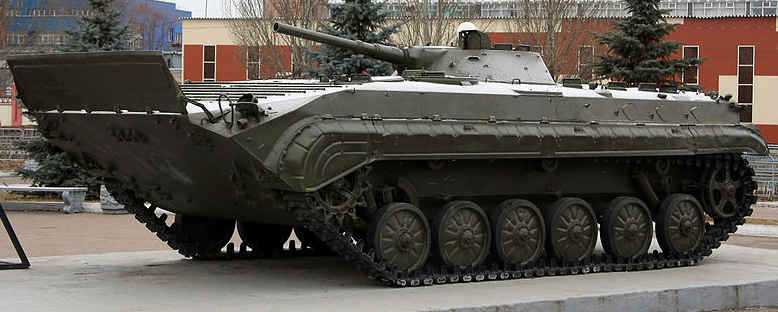
BMP-1 on display at Victory Park, Kazan. When revealed publicly in 1967, it caused a stir with Western officials. There was no equivalent in the arsenal of the free world then.
The concept of IFV
The BMP-1 was in rupture with current Mechanized infantry tactics of the red army at the time, in which Armoured Personnel Carriers (APCs) followed tanks until they were in action, unloaded troops and then retire in a safer area, whereas the German IFVs were specific successors of the ww2 Sd.Kfz.250/251 (Hanomag) delivering dedicated tank troops known as the "panzergrenadiers" and taking an active part in the battle, directly in close cooperation with tanks. Therefore, thinkers in the Soviet Army had the idea at least to test an hybrid between an APC and a tank, which was to became the very concept of an Infantry Fighting Vehicle, a unique creation of the cold war. Not really a light tank nor an APC this was a new category for a traditional tactical assignment, and a successful one which indeed nailed the coffin of the light tank and added an upper level to the APC genre at large.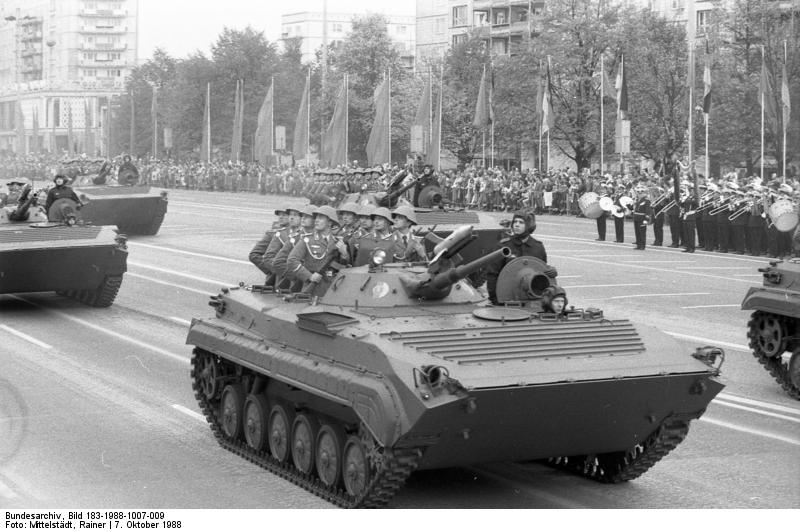
East German BMP-1 at the Berlin parade, showing the 8 infantrymen carried standing at the rear. They could fire on the move through the sides and doors pistol ports or from the four roof's hatches.
Development
The task of designing the BMP was assigned to Pavel Isakov, head of the Design Bureau of the Chelyabinsk Tractor Plant (ChTZ), which tracked Ob'yekt 764 was chosen. The famous plant founded in 1933, seated south of the Ural mountains, well beyond reach from the Germans in WWII, did indeed mass-produce the KV-1 and T-34 which contributed to halt the Panzers, and cranked-up thousands of KV-85s, IS series, T-34/85s, as well as the SU-85 tank hunter.Specifications were drawn up in the late 1950s already and there were questions about the nature of the vehicle, either wheeled or tracked or even hybrid. They specified a good speed, good armament, and crucially the ability for all squad members to fire from within the vehicle, whereas infantry had to dismount of traditional APCs. Protection had to be superior, including against similar rank weaponry, 20–23 mm caliber autocannons across the frontal arc, and a collective NBC protection was also already envisioned.
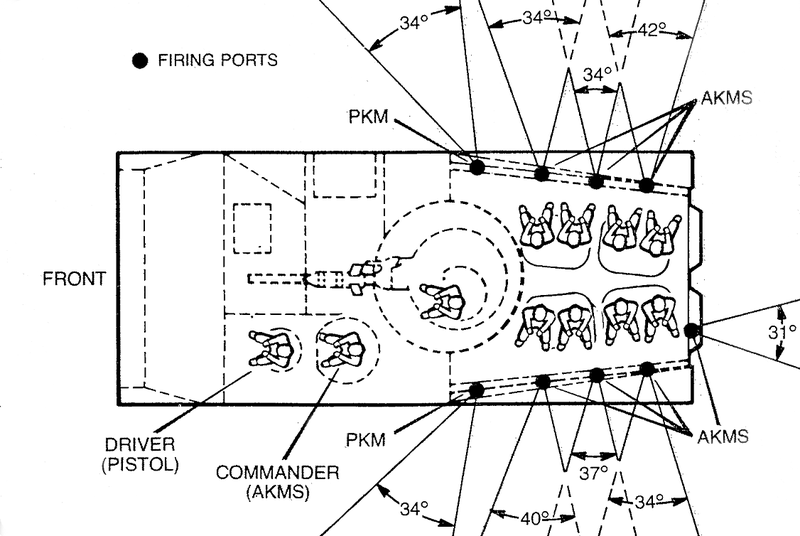
Schematics of the crew composition and firing arcs Versatility against a wide range of targets was obtained by mating a gun to the vehicle's turret such as the compact 73 mm 2A28 Grom gun, and fitting the brand new ATGM in development then, the famous Malyutka 9M14 Malyutka (AT-3A Sagger A) to engage and destroy tanks from the 500 m range (gun) to the 3000 m range (missile) (550 to 3300 yds). The Ob'yekt 764 allowed the infantry of disembarking from rear doors (making them less vulnerable) thanks to the placement of the engine at the front left-hand side and the tracked solution made it of a lower silhouette, a crucial advantage seen in a traditional Russian tank design perspective.
It was built in 1964, tested and improved, then followed by modified Ob'yekt 765s and accepted in service in 1966 under the designation BMP-1. Three prototypes of the latter were built and tested by an active unit (the 120th Guards Rifle Division), which differed by minor details, ranging in weight from 12.6 to 13.2 tons (final vehicle) and therefore a power-to-weight ranging from 22.7 to 23.8 hp/ton, but with the same armament and protection.
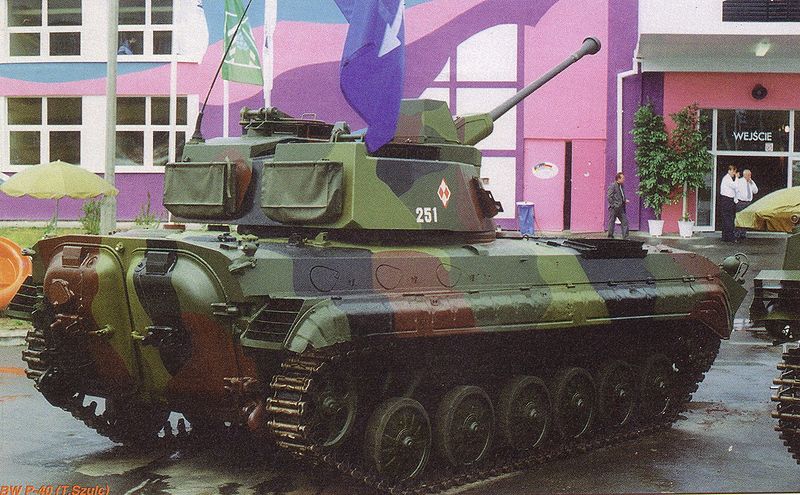
Polish BWP-40 Infantry Fighting Vehicle
Design
General Arrangement
The hull arrangement was as follows: The driver was at the front left-hand side, with his own hatch above and three TNPO-170 periscopes covering the frontal arc, the central one could be swapped for an active binocular TVNO-2 IR sight. In addition, he is given the TNPO-350B raised periscopes used for driving when the trim vane is erected (when swimming). For self-defense, his right-side opening hatch is given a pistol port. Behind him was the commander, with his own two-folded hatch, the upper half being lifted and used as a shield. He too had three vision blocks. He has a removable OU-3GA2/OU-3GK infrared searchlight (range 400 meter/440 yds)) which is coupled with a day/night TKN-3B binocular sight with a 5x/4.2x magnification. The TNPO-170 vision devices have all cleaning and heating systems. The commander is in charge of the R-123M radio.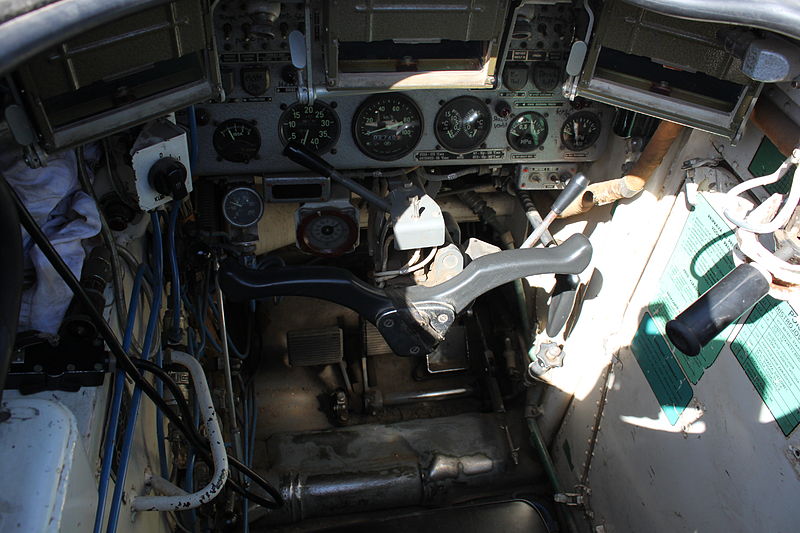
Driver cabin overview
The third member of the crew, the gunner, took place in the seat right of the gun's breach. He can access easily to ready rounds stored around him on the sloped walls cradles, and the turret traverse is electric, but with a manual backup. There is a fume extraction system. The gun's breach is low in the turret, therefore it has a dead zone over the commander's hatch, the searchlight being in its way. Current practice was to leave the gun raised enough to avoid it. His main sight is the dual mode (day/night) 1PN22M1 image intensifying monocular periscope which had a 6x/6.7x magnification.
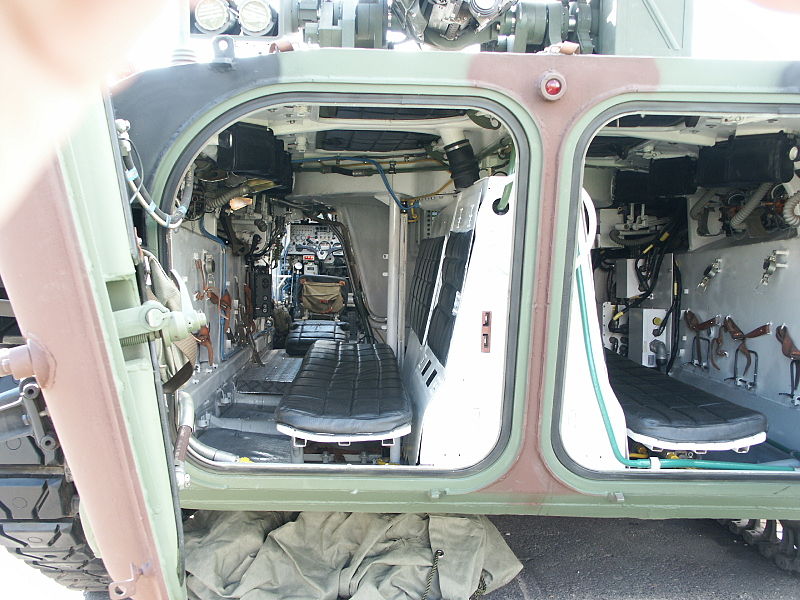
Polish BWP-1 crew compartment
Vision range varies from 400 meters (440 yds) to 900 meters (980 yds). This is completed by a set of 4 periscopes and an optical rangefinder. In addition, the OU-3GK infrared or white-light searchlight can be fitted to the gun. This is a stadiametricly ranged sight, replaced later by a 1PN22M2 sight in the 1970s which allowed the use of the OG-15V HE-Frag round. The range scale was raised to 1,300 and 1,600 metres (1,420 - 1,750 yd).
Protection
The famous wedge-shaped welded rolled steel hull (seen from profile) did not tell of a wide vehicle (2.94, almost three meters for 6.7 m long), and quite low (only 1.88 m high on the turret top) which means troops can easily climb over the vehicle. This was seen as a crucial advantage during the Afghan war, as the fear of mines made the troops preferring to stay above the vehicle rather inside. With its low, flat and weak belly, the BMP was indeed an easy prey for these devices. Armour protection ranged from 6 mm to 33 mm (main gun mantlet) (0.24 to 1.30 in), the frontal arc being able to withstand 23 mm autocannon AP rounds, the sides of the vehicle being resistant against 12.7 mm heavy machine gun rounds, and the rear and roof to small arms fire and shrapnel.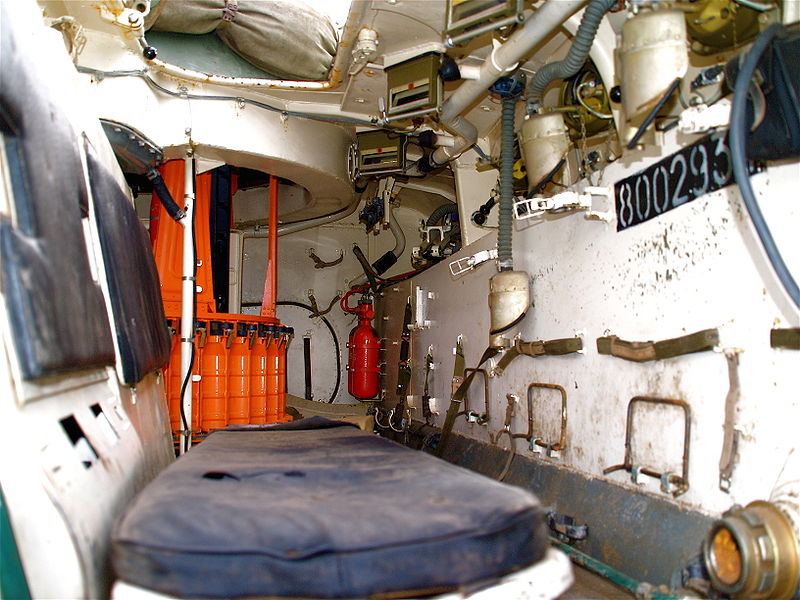
Troop compartment overview
Furthermore, the high angle beak made it likely to deflect all sorts of rounds and on top of that, the upper nose was protected by the added layer of the trim vane. In detail, the turret was 26–33 mm on the gun mantlet, 23 mm (42°) on the turret front, 19 mm (36°) sides, 13 mm (30°) rear, and 6 mm (top) while the hull upper front was 7 mm at 80°, 19 mm (57°) lower front, 16 mm (14°) upper side and 18 mm lower side, and 16 mm (19°) rear, 6 mm on the engine deck and 7 mm on the belly rear. This level of protection, however, did not prove immune to the 25 millimeters (0.98 in) M242 Bushmaster autocannon Armour-piercing rounds. Total weight was 13.2 tonnes (13.0 long tons or 14.6 short tons) battle ready, which was 1/4 of a standard MBT weight at the time.
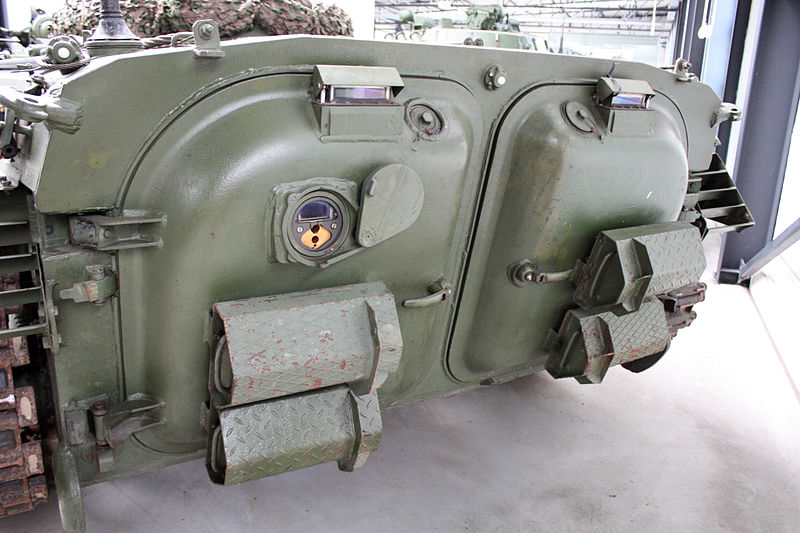
Rear doors (Munster museum)
The BMP-1 crew protection consists of a collective chemical weapons, biological agents and nuclear fallout threats (NBC) lining, sealing, and by an air filtration system (blower/dust separator and filters) and overpressure system. However, there was no air conditioning or air cooling system, making the crew compartment's conditions unbearable in hot climates and force it to open hatches when idle or moving, weakening protection against shrapnel and small arms fire in ambushes from higher up. For active protection, the BMP was given only the possibility of creating a thick white smoke cloud by injecting vaporized diesel fuel into the exhaust manifold (TDA engine thermal smoke generating system). Many vehicles modernized in the 1980s were given banks of smoke grenades dischargers.
Mobility
Standard production version had the UTD-20 V6 (6 V-shaped cylinders) 4-stroke diesel which had an airless-injection, and water-cooled and multifuel, and 15.8 liters of capacity. It developed 300 hp (224 kW) at 2,600 revolution per minute, which gave a power/weight of22.7 hp/tonne (17.0 kW/tonne). Top speed on flat was 65 km/h (40 mph) on the road, 45 km/h (28 mph) off-road, on average and 7–8 km/h (4.3–5.0 mph) when swimming. The driver fatigue is much reduced by a power-assisted manual gearbox with five forward and one reverse gear. Suspensions consisted of individual torsion bars, with hydraulic shock absorbers on the 1st and 6th road wheels, which are heavenly spaced, but with a slightly greater gap at the rear (less weight). The drive sprockets are at the front, idler at the rear, and the tracks are supported by three return rollers per side. The 6 rubber-clad roadwheels per side are of the standard stamped steel hollow model, mass-produced and shared by many other Soviet vehicles. The upper part is protected from snow and dirt by rigid side skirts.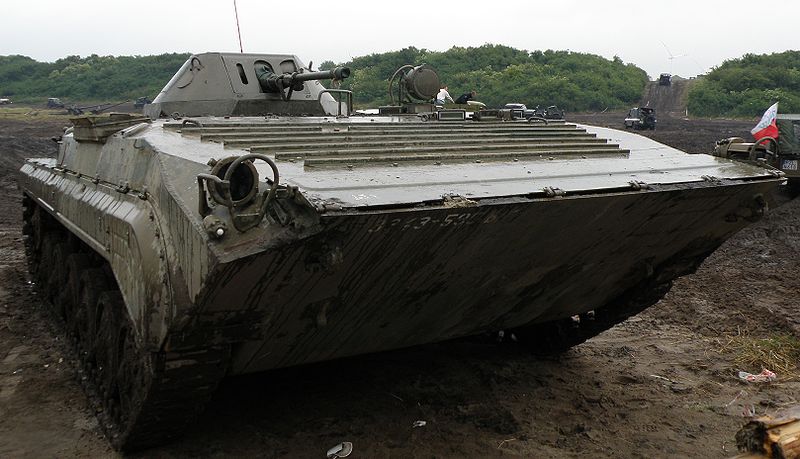
Czech OT-90 at the 10th International rally of Historical Army vehicles at Darlowo 2014, Poland.
The field performances of the vehicles are as follows: It was able to climb a 60% gradient, a 30% side slope, 0.7 m vertical step, cross a 2.2 m wide trench, and of course ford any kind of water surface, due to floating amphibious capabilities. In that area, it is helped by its tracks in motion and some buoyancy produced by the hydrodynamic fairings on the track upper side covers as well as road wheel arms with air chambers and hollow stamped roadwheels. The shape itself of the hull and the trim vane when erected also have good characteristics although the BMP was never intended for sea landing operations. It could only cope with 25 cm (0.82 ft) high when swimming at sea. Preparations include closing tight the rear doors.
Thanks to an internal maximal capacity of-of 462 liters (102 imperial gallons of 122 US gallons), operational range is 600 km (370 mi) on flat to 500 km (310 mi) off-road in average, with the versatility of a multifuel feeding, accepting either regular diesel but also winter DZ fuel and even TS aviation-standard high octane kerosene. The size and weight of the BMP-1, however, made it only air-transportable tactically by heavy-duty carriers like the Ll-76 and possibly lifted up by the Mil-Mi-6 Helicopter but not-air-droppable. The BMD-1 and their followers were IFVs specifically designed to solve the issue are being seen as "airborne BMPs".
Firepower
The core of a good IFV is certainly its armament, and the BMD was well-conceived in this chapter, with a conical turret inspired by the one seen on the PT-76 light tank and also shared by the BMD-1. It was out of the question to give this vehicle a standard tank turret due to its weight and inherent structural problems and the light one-man turret was designed to operate a tailored 73 mm 2A28 "Grom" low-pressure smoothbore semi-automatic gun. There is a 40-round magazine which is located at the base of turret ring, surrounding the gunner. With a cyclic rate of fire 8-10 rpm, and an elevation of 3° it is certainly not intended to fight helicopters, but only light vehicles and fortified objectives.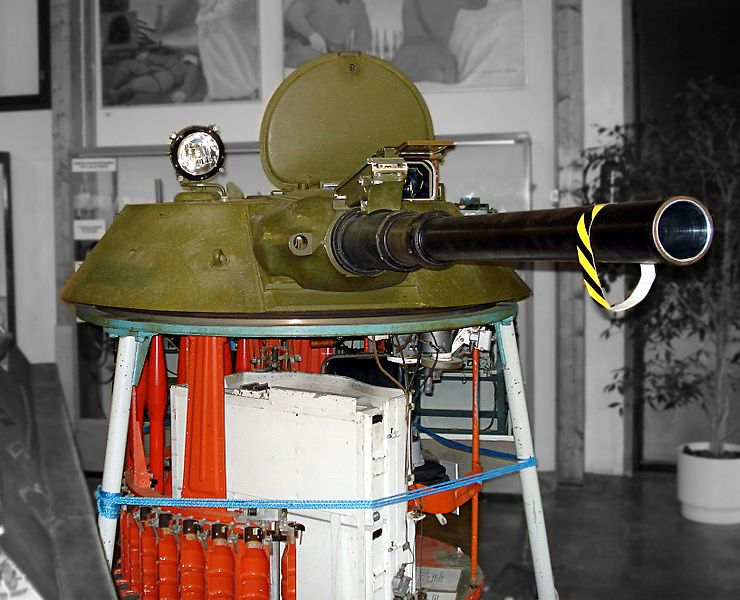
BMP-1 turret at the Parola training center, Finland
The gun breech is conceived around an autoloader, fed from the mechanized ammunition conveyor magazine but it can be also manually reloaded. It was apparently not very successful and often removed after delivery. Furthermore, in 1974, a new ammunition was introduced, which can only be loaded manually. Standard projectiles are the same PG-15V used on the SPG-9 infantry light recoilless gun. Only the smaller propellant charge differs. The main AP projectile is the PG-15V HEAT which can penetrate up to 280 to 350 mm (11 to 14 in) of steel armor while the modernized PG-9 was found able penetrate up to 400 mm (16 in) of steel armor but only at an effective range of 500 m (550 yds). Against soft targets in infantry support, the OG-15V high explosive was only supplied from 1974.
Secondary armament comprised a right-mounted coaxial 7.62 mm PKT light machine gun, supplied with 2,000 rounds and can use tracers to aim the main gun. Indeed it is not stabilized, which reduced the first-hit capability and negate any effectiveness when in motion. For the long-range defense bubble, the BMP relies on a single ATGM mounted on a launching ramp above the main gun mantlet. The first used and produced en masse was the 9M14 Malyutka (NATO AT-3A Sagger A), later replaced by the Malyutka-M and P in the 1970s. It gave the vehicle a MBT-killing capability at a 3,000 m (3,280 yds) maximal range. These missiles can defeat 400 mm (16 in) of steel armor, using a HEAT warhead. Four of these are carried inside complete with their own launching ramp between the turret and hull, which means that in battle the crew needed to reload it exposed to the enemy fire.
Evolution (1966-90)
Manufacturers were the Kurgan Machine Building Works (Kurganskiy Mashinostroitelyniy Zavod) for the main IFV version, Chelyabinsk Tractor Works (ChTZ) for the reconnaissance vehicles and Rubtsovsk Engineering Works (RMZ) for the PRP-4/PRP-4M artillery reconnaissance vehicles. KMZ was charged with the upgrades, repairs and maintenance. In total, 20,000 were built in USSR alone, along with many thousands more built under license by Czechoslovakia (BVP-1, perhaps 1800 total -2252 BMP-1/2 in 1992), Romania (MLI-84), India, or China (Type 86, 3000+)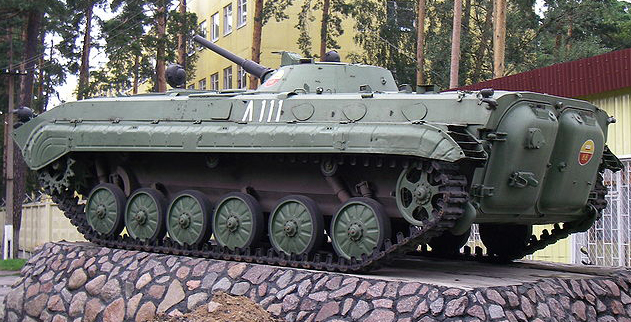
BMP-1 in Lebyazyhe, rear view
Production prototypes:
The (Ob'yekt 765Sp1 (1966-69) weighted 12.6 tons for a power-to-weight ratio of 23.8 hp/tonne (17.8 kW/tonne). It was followed by the improved Ob'yekt 765Sp2 (1969-1973, 13 tonnes but 23.1 hp/tonne) and the Ob'yekt 765Sp3 (1973-79, 13.2 tonnes, 22.7 hp/tonne ratio). The latter was improved chiefly in its chassis, engine and transmission. All have in common the 73 mm 2A28 "Grom" low-pressure smoothbore semi-automatic gun and 9M14 "Malyutka" ATGM.BMP-1P (1979)
This version was heavier (13.4 tonnes), had a new ATGM, the 9M113 "Konkurs" (AT-5 Spandrel) alternative with the 9M111 "Fagot" (AT-4 Spigot). The engine remained unchanged but performances were slightly lower due to a 22.4 hp/tonne (16.7 KW/tonne) power-to-weight ratio. The BMP-2 was slightly lighter and armed with a 30 mm autocannon, unlike the heavier BMP-3 of 1987 which reverted to a 100 mm gun and 30 mm coaxial.The BMP-1 in action
The first unit to receive the vehicle was the 120th Guards Rifle Division, which tested prototypes of the Ob'jekt 765 infantry fighting vehicle from January to November 1965. The program under Guards Major Vasiliy Samodelov helped secure a pre-production in 1966, and mass-production was launched the next year. BMP-1s were revealed to Wester medias during the 7 November 1967 military parade in Moscow, creating a stir among specialists as lightly armed and protected APCs were the norm. So far only West Germany ventured into the concept, not really convincing. Tactically these vehicles were issued to motorized rifle divisions, and the motorized rifle regiments of tank divisions, when replacing older BTR-152 wheeled APCs, but also BTR-50P and BTR-60P. Soviet tanks specialists endlessly debated over the intended role or even utility of the BMP concept, since it had weak armor and light armament compared to any MBT, but thus, had to work in close cooperation at the heart of the melee, and was also far more expensive than wheeled APCs. As conventional warfare regained favor in the late 1970s new ways to use the BMP needed to be redefined again, taking into consideration the obvious large availability of ATGMs in the allied arsenal to cope with the large numbers of Soviet vehicles. At last, having soldier inside could be used judiciously either when making a breakthrough, or pursuing retreating forces.Yom Kippur war (1973)
The first engagement of the vehicle occurred on 8 October 1973 when the Syrian (between 150 and 170) and Egyptian Army (80+150 in July-September) which just purchased hundreds of BMP-1s engaged them against the Israeli Army. Syria only engaged about 100 vehicles in the front line, the remainder was used by Hafez al-Assad's guard. Many Syrian vehicles engaged on the Golan Heights at Quneitra were lost due to mechanical features and inexperience of the crew. The short range of the gun was also criticized and the ATGM was difficult to aim accurately. However, both the Egyptian and Syrian crews praised its speed and agility. In particular, it was found capable to cross the reputed impassable northern Kantara salt marshes. Egypt had vehicles with its mechanized infantry battalions of tank and mechanized infantry divisions Lessons were precious for Soviet engineers, although for USSR itself the real test came with the war in Afghanistan.Angolan Civil War
BMP-1s were used by Angolan and Cuban units against South African forces. More than 300 light AFVs of various types were delivered to Angola in 1975-1976 and proved themselves quite useful. A few Czech BVP-1 "Strop" SPAAG has been also spotted in action with Angolan and Cuban forces. Six BMP-1s were destroyed plus six others captured by SADF at Cuito Cuanavale (Oct. Nov. 1987) and the captured ones have been thoroughly evaluated. A modernization package was even designed with the IST Dynamics Unmanned Multi-Weapon Platform for export.Iran-Iraq war
BMP-1 was purchased in quantities by Iraq, with the first batch of 200 vehicles in 1973 from USSR (delivered in 1974 and 1975) and 750 more apparently Czech-built and delivered from 1981 to 1987 for a total of 950 BMP-1 active in the Iran-Iraq conflict. These were useful to deal with Iranian massive human waves but shown vulnerabilities that were fixed with later upgrades, prior to the Kuwaiti invasion.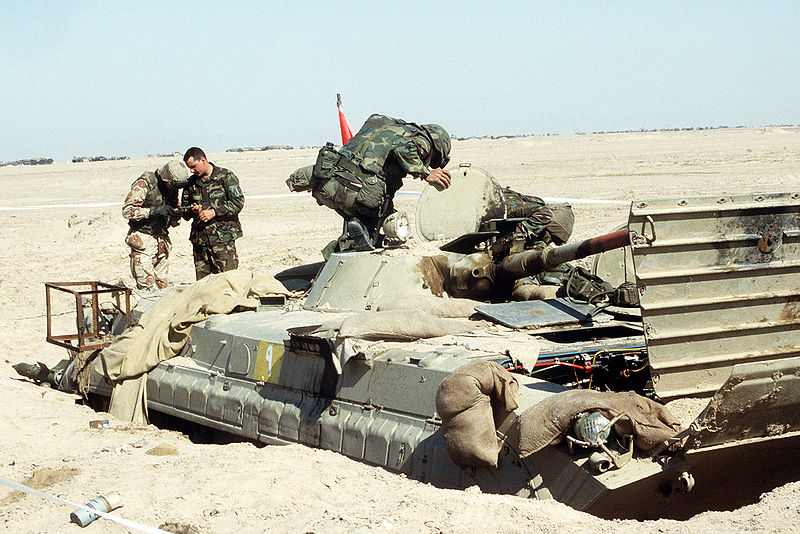
Gulf War (1991)
In addition to unknown numbers of Chinese Type 86s (A cheaper copy of the BMP-1), Iraq had some 1,500 BMPs of all types in the inventory by 1990. At that stage, two variants were developed: A up-armored variant called "Saddam I", first revealed in the 1989 Baghdad exhibition. It had locally manufactured appliqué armor panels on the sides of the hull and turret and looked like the Soviet "Afghan" variant (BMP-1D). Other panels protected possibly also the nose and underbelly against mines. However the overload was not compensated by an engine upgrade, and the vehicle was consequently never produced, contrary to the second variant, the Saddam II, that received rubber side skirts, additional (lighter) armor on the upper hull sides and an ATU box. The few produced were given to the Republican Guards. There was also an armored ambulance conversion from 1985 (NATO BMP-1SM) which was turretless and had a stretched rear section.In 1991 the showdown with US Forces placed these 1800 BMPs against about 2,200 M2 Bradleys and M3 AFVs. To take word for word Bradley crew's impressions, "we've butchered these things left and right". During the battle of Medina Ridge, a single Bradley knocked out a first BMP with just three 25 mm chain gun rounds, and two with nine in a 60-second firefight with various Iraqi Republican IFVs. On 26 February 1991, the American VII corps engaged several units north of Kuwait at 16h20pm knocking off 13 BMP-1s (as well as 13 T-72s), and at 18h30 four more by Abrams tanks. However, in the Battle of 73 Easting, an Iraqi BMP-1 knocked out a US M2 Bradley with its 73 mm.
The first bounce off the armor but the second penetrated beneath the TOW ATGM launcher, killing the gunner and wounding the rest of the crew. On 2 March 1991 when dealing with the breakout attempt from the Iraqi "Hammurabi" Republican Guard division, US 24th armored division Bradleys were fired upon, until AH-64 Apaches were called to help, destroying 49 BMPs among others. The remnants of the IFVs were still active in the 2003 war in Iraq. About 434 are in service nowadays with the Iraqi new army and its 1st Mechanized Brigade based in Taji. Some of these are former Greek "Ost" NATO-standardized vehicles in Germany.
Ex-USSR republic conflicts
The Nagorno-Karabakh War saw the Armenians capture 49 BMP-1s (Russian 366th motorized rifle regiment) about to be withdrawn from Stepanakert in March 1992. Azerbaijan lost 38 BMP-1s until 1994 and Armenia 51 to 53 IFVs in action, while the latter also tested and converted six 9M14M "Malyutka" ATGMs on an elevatable (from the BRDM-2 based 9P122 tank destroyer) at the turret rear top.In the War in Abkhazia (1992-1993) Georgia had an overwhelming superiority in the number and received in addition 111 BMP-1s from the withdrawn Russian 10th motor rifle division (Akhaltsikhe) plus 6 more given by the Ministry of Internal Affairs and later an additional 25 BMP-1s were captured in the Tbilisi tank repair workshops. The Abkhazians obtained however dozens of BMP-1s either captured or delivered from Russia. At the Battle of Gagra (2 October 1992), 12 Georgian BMPs were captured by the Abkhazians, and 2 were later destroyed and 4 more captured. At the Abkhaz night offensive on Shroma the Georgians lost 2 BMPs versus 4 Abkhazian BMPs on 3–4 November 1992. About 70 IFVs were committed in the Sukhumi area before the Abkhaz offensive (15 March 1993) and the Abkhazians placed additional side armor screens on their BMP-1s.
Other conflicts
Lebanese Civil War (1975–1990), Western Sahara War (1975–1991), Chadian-Libyan Conflict (1978–1987), Toyota War (1986–1987), Sri Lankan Civil War (1983–2009), Georgian Civil War (1988–1993), War in South Ossetia (1991–1992), War in Abkhazia (1992–1993), Nagorno-Karabakh War (1988–1994), Georgian-Ossetian conflict (1989), Civil War in Tajikistan (1992–1997), Civil War in Yemen (1994), United States War in Afghanistan (2001), South Ossetia War (2008), Libyan civil war (2011), Second Ivorian Civil War (2011), Syrian Uprising, Donbass War (2014).Weaknesses of the BMP-1
However, through exercises and later battlefield experience, the limitations of the BMP appeared rapidly: The soldiers were carried on each side of the central fuel tank and ammo dump, creating a severe risk of knock-off blow in case of a hit, as well as the base of the turret crammed with live ready rounds. But the vehicle showed many other protection issues:As revealed in Afghanistan when an AT mine blasted the left track it also destroyed one of the road wheels that penetrated often the bottom, killing or wounding the tandem driver and/or commander, specialized personal which were long to train. In response, the latter often lay down sandbags on the bottom of their compartment. However, the effect against the right track was often less dramatic. The effect of a tilt-rod antitank mine due to the shape of the hull was also quite bad. This conducted to develop the so-called "Afghan variant", with improvized add-on armor plates. On the BMP-2 the position of the driver and commander were changed, and the problem was solved. The other major issue was the fact the ammunition was stored near or even inside the fighting compartment, for any side mine blast or RPG hit, it was a 100% loss due to the likely explosion (95% of cases.).
So as a paradox, Soviet soldiers used to rode on the roof of the BMP-1 in Afghanistan rather inside for safety, that nullified the need of an armored transport to start with. Ironically US Marines and privates of the US Army did the same in Vietnam on their M113s. A clear demonstration of the aspects overlooked by engineers when designing an armored transport...
A problem also shown in exercises was the reloading operation of the 9M14 "Malyutka" "Malyutka-M" ATGMs in NBC conditions, through a small hatch from the inside, that nullified anyway the advantage of a collective NBC system. It was also shown, this time in the Gulf War with Iraqi BMP-1 that their armor front could cope with light AP rounds of the 1970s, but not modern ones: A great deal of BMP-1s were literally "butchered" by modern AP cannon rounds of the M2/M3 Bradleys.
Also, the main fuel tank design and location was a serious issue. Indeed the engineers had to make comprises due to the size and height of the vehicle. If a hit (especially an incendiary round) took place between two rows of outward-facing seats the compartment just became an oven when the flames moved into the crew compartment. It was the same with the exposed rear door additional tanks. And the effect was compelled if the regular diesel was replaced by high-octane kerosene! However in practice, the BMP-1 often operated near their operational base and instructions were given to fill these doors with inert sand, that created instead an additional protection layer. That was a precious advice as shown in Chechnya, as the rebels tended to target these weak parts of the IFVs/APCs.
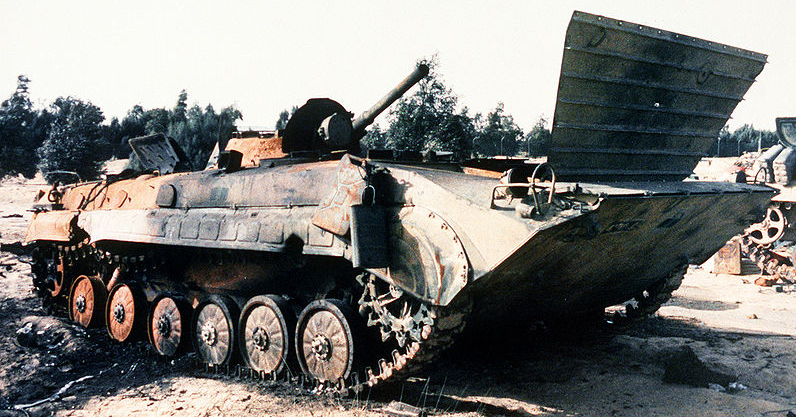
Iraqi BMP hit several times and abandoned, Operation Desert Storm 1991
Also, the troop seating layout was a problem. Because of the use of the pistol ports on the side walls, infantrymen were seated in the center back to back. A magnetic anti-tank mine could kill the entire crew, whereas it showed blasts effect were less severe when the infantrymen were seated opposite on the walls as in most APC/IFVs today, all for dubious benefice as most infantrymen were poorly trained conscripts to fire on the move. In any case, comfort was secondary anyway, and there was no air conditioning or air cooling system, forcing the crew to open hatches in hot climates, compromising the NBC protection, and rendering them vulnerable to machine gun fire from higher ground as it appeared in Yom Kippur and Afghanistan.
The Soviet Union produced more than 20,000 BMP-1s and vehicles based on its chassis, all combined. In 1972 as many as 5,100 BMP-1s Czech vehicles were ordered and delivered to USSR in 1972-1988. At the eve of the Afghan war in 1980, 14,473 BMP-1s were in service in USSR, and in 1985, combined with BMP-2, around 24,000 were still in service, despite the losses. Most were passed on to successor states. Today Russia still operated 12,200 BMP-1/2/3 but this was radically reduced until 2009 and only 1,543 were in active service by then with around 9,057 in reserve. As of today less than 750 of the modernized type are maintained in active service (roughly 10,000 in reserve by 2009).
In Soviet service
The BMP-1 was active in some units since 1966 but it was revealed publicly on the 7 November 1967 military parade in Moscow. The reaction in the West was one of surprise, at this vehicle did not enter in standard models. It did not look the part as an APC but was not doubling as a light tank anyway since the PT-76 was already in service. Moreover, there was no equivalent in the Western block. As a reminder, the first IFVs would appear in US service in the 1980s, as the Bradley. That was a significant gap of 10 to 15 years without an equivalent produced in numbers in the free world. The BMP-1 was given to motorized rifle divisions and the motorized rifle regiments of tank divisions, replacing tracked lightly armed BTR-50P and wheeled BTR-152 and BTR-60s.Afghanistan
BMP-1s were at the forefront due to its large availability and better protection/armament than regular APCs. It was operated both by motorized rifle and tank units but also Soviet special forces units. However, they quickly showed their limitation in a mountainous terrain being originally conceived for open plains across and forested areas of Europe, in nuclear conditions. In the constraints of narrow roads and impassable surrounding terrain the BMP-1 fell prey of landmines, Mujahideen ambushes, its AT capabilities being useless. This experience led to upgrading the model as the BMP-1D (sometimes "Afghan" variant), urgently pressed into service in 1982. Additional field modifications were also applied by various units. The welding of an additional AGS-17 "Plamya" automatic grenade launcher to deal with these mountain ambushes, replacing the ATGM launcher or a 2B9 "Vasilek" 82 mm automatic gun-mortar on the roof of the troop compartment, were commonplace.The 73 mm OG-9 HE-Fragmentation round was conceived to deal with soft skin targets and infantry but has a large dispersion and was inaccurate, low range and muzzle velocity, meaning it was sometimes unable to find its targets through cob walls. Instead, the PG-9 HEAT (antitank) round was used to deal with Afghan pise buildings but its fragmentation effect was rather poor. Therefore the BMP-1PG (Ob'yekt 765Sp8) developed by Kurgan Engineering Works, was given an additional AGS-17 grenade launcher, installed on the left-hand side of the turret roof. A few BMP-1s were also used in Afghanistan to support for airborne operations with RPG-16 airborne shoulder-launched anti-tank RPGs from BMD-1 IFVs.
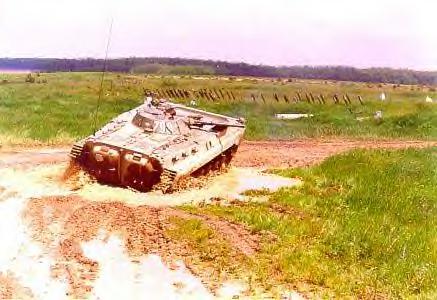
Hungarian BMP-1 Soviet Variants:
The evolution of the type comprised the model 1966, 1969, 1973 and 1976 by NATO. Soviet nomenclature pointed out the specification prototypes they were based on, from the Ob'yekt 765Sp1 to Sp3. Check the illustrations below for more about BMP variants and derivatives.
- BMP-1s: Experimental, tested the AV-1 commander's laser designator/optic jammer.
- BMP-1 (Ob'yekt 765Sp8): NATO BMP-1G/BMP M1979/1, 30 mm AGS-17 "Plamya" automatic grenade launcher.
- BMP-1P (Ob'yekt 765Sp4)(NATO M1979): Better ATGMs and guidance, improved NBC and fire extinguishers.
- Sub-variant Ob'yekt 765Sp5 fitted with 2x3 turret rear 81 mm 902V "Tucha" smoke grenade launchers, add-on kovriki turret armor, and in some cases track-width KMT-10 mine plow. NATO designation BMP-1PM/1/2.
- Subvariant BMP-1PG (official for granatomyot – grenade launcher) with AGS-17 "Plamya" automatic grenade launcher (290 grenades in storage), possible compensation for the low frag effect of the OG15V HE-Frag, 9K34 "Strela-3" MANPADS and reduced crew (7 instead of 8)
- BMP-1D: For "desantnaya", assault. Specialized version developed for Afghanistan in 1982. 5–6 mm thick appliqué steel armor plates against mine blasts, side armor, additional firing ports in the troop's top hatches rear roof stowage box and an AGS-17 "Plamya" automatic grenade launcher replacing often the ATGM launcher.
- Ob'yekt 768 (1972-73), prototype with a two-man turret armed with a 73 mm "Zarnitsa" semi-automatic sb gun plus 12.7 mm coaxial HMG and SACLOS guided 9M113 "Konkurs". Stretched chassis with additional roadwheels and reinforced suspensions, modified nose section and tracks hydrodynamic profile.
- Ob'yekt 769, same as above but 2A42 autocannon plus 7.62 mm PKT, plus one in a secondary roof turret and 321 hp (239 kW) diesel engine.
- Ob'yekt 680 (1973) with a 30 mm 2A38 autocannon plus PKT and new turret.
- Ob'yekt 675 (1974) 2-planed stabilized 2A42 gun, SACLOS guided 9M113 "Konkurs" and better guiding system.
- Ob'yekt 681 (1977) stabilized 2-plane 73 mm "Zarnitsa" plus coaxial 12.7 mm NVST and 9P135M ATGM.
- BMP-1K (Ob'yekt 773), production command version of 1972. NATO M1974. Troop compartment modified for field tables and maps boards, three seats, firing ports welded shut, armament preserved but reduced ammo capacity. R-123M and R-111 radios and a GPK-69/GLONASS navigation system, three sub-variant with varying radio equipment at the unit level (platoon/Company/Battalion) K1/2/3 respectively. Improved BMP-1KM
- BMP-1PK for motorized rifle regiments with the same K1/2/3 gradation.
- BMP-1KSh (Ob'yekt 774) command-staff variant, fixed turret, no armaments, new telescopic antenna...
- Sub-variants of the KSh, the 1KShM and MP-31 (BMP-76) which had a better electrical generator, for artillery fire control
- BRM-1 (1972): Main reconnaissance variant, the first specialized electronic reconnaissance vehicle in the Soviet Army. Built by Kurgan Engineering Works (KMZ).
- BRM-1K: Command variant of the latter.
- PRP-3 "Val" mobile reconnaissance post for artillery units. Also produced by the Rubtsovsk Engineering Works in 1979. R-123M or R-108 radios and new optics, new larger turret further back, one PKT.
- PRP-4 "Nard" (1980) modernized version, with more modern equipment and 1RL-133-1 "Tall Mike" retractable battlefield surveillance radar
- PRP-4M "Deyteriy" (1988) better thermal vision, laser RF. Variant with a fake gun.
- BMP-1PO resupply vehicle with ammunition racks inside the rear doors
- PPO-1 training vehicle by CTZ design bureau with eight roof-mounted stations for the students
- BREM-2 ARV maintenance and recovery vehicle. No turret, casemate with jib, crane, winch, dozer blade
- IRM "Zhuk" CEV (Combat Engineering vehicle) 1980. Variant IPR for amphibious reconnaissance
- PRP-4MU (1990s) upgrade for previous models by the Rubtsovsk Engineering Works
- BMP-1 "Razbezhka" (1990s) prototype with BMD-2 turret
- BMP-1-30 with 30 mm V-30 gun and 360 hp UTD-230 diesel (1990 upgrade)
- BMP-1 OWS-25, prototype testing the Israeli Overhead Weapon Station 25 mm autocannon
- BMP-1M (1998) all out modernization for export - see the illustrations for more details
- BMP-1M "Bakhcha-U" with the Tula KBP with BMP-3 100 mm 2A70 gun/missile launcher.
- BTZ-3 armored refueler (experimented in the First Chechen War)
- RM-G repair vehicle conversion by Rubtsovsk Engineering Works (1995)
- ATM "Berezina" civilian multipurpose emergency transport vehicle for remote places
- LPM-1/2 forest fire fighting vehicle (1992)
- Zaisan-2 civil emergency vehicle
- Taiga civil logging tractor
- Afghan BMP-1/ZU-23-2, SPAAG conversion for close support.
- Bielorussian BMP-1P/2A42 Cobra upgrade, including ERA armor
- Bulgarian BMP-1KShM-9S743 conversion to local MP-31 version
- Chinese Type 86 IFV. Local reverse-engineered copy (numerous variants)
- Cuban BMP-1/122 mm D-30 SPH, 2 variants
- Czech BVP-1 local version
- Czech BVP-1K
- Czech BPzV "Svatava"
- Czech BVP-1 "Strop"
- Czech Vz.85 ShM-120 PRAM-S 120 mm mortar
- Czech BVP-1 AMB-S armored ambulance
- Czech VPV ARV conversion
- Czech SVO mine-clearing vehicle
- Czech "Bouře III" for PsyOps with retractable loudspeaker system
- Czech OT-90 with OT-64A turret (infamous "Vaclav's Tigers")
- Czech sub-variants DTP-90/DTP-90M/DP-90/MU-90/OZ-90/VP-90/ZT-90/ZV-90
- Czech (modern) BVP-1MA/MB/Tania upgrade (1990s)
- Czech (modern) OT-90M1/M2/M3 upgrade
- Czech (modern) BVP-1SM turretless armored ambulance
- Czech (modern) BVP-1PPK/PzPK "Snĕžka" armored artillery recce vehicle
- Czech (modern) OT R-5/5M/5M1 "Bečva" specialized command vehicle
- Czech (modern) MPP 40p BVP signals vehicle
- Czech (modern) BVP-1 LOS specialized light recce vehicle
- Czech (modern) MGC-1 with improved protection ERA or NXRA, etc
- Egyptian BMP-1S re-engineered with a French Poyaud 520 6L CS2 diesel 310 hp (1979), 200
- Finnish BMP-1PS no autoloader, 76 mm Wegmann and 71 mm Lyran smoke grenade launchers
- Finnish BMP-1TJ/TJJ "Tuija" artillery reconnaissance vehicle
- German BMP-1A1 Ost former 581 East-German vehicles to NATO safety standard, no ATGM, most resold to Greece
- Greek BMP-1A1 Ost/ZU-23-2 SPAAG. Conversions are ongoing.
- Hungarian BMP-1F with smaller crew (3-5 infantry)
- Indian BMP-1: Licence-built, modified turret with Bren MG mount at the rear.
- Iranian Boragh: local reverse-engineered copy of a BMP-1 or Type-86
- Iraqi BMP-1 Saddam II with appliqué armor rubber sideskirts, Rep. Guards
- Israeli BMP-1 Nimda upgrade and CARDOM 120/81 mm mortar conversions
- North Korean Korshun (possible Type 86 copy)
- Polish BWP-1 locally produced version with extra 7.62 mm PK LMG mantlet/turret/hull
- Polish BWP-1M "Puma 1" all out modernization 2000s, 7 sub-variants (some experimental)
- Polish BWP-40 BWP-1/CV9040 hybrid for export
- Polish BWP-95 no turret, RWS with 23 mm cannon and recoilless rifle for export.
- BWP-1D local command version
- BWR-1S local "Svatava" recce version
- BWR-1D local recce/command variant
- ZWDSz-2 Modernised MP-31, wt telescopic mast
- Romanian MLI-84 – Romanian produced version of the BMP-1
- Slovakian BVP-1 2A48 Cobra overhead mount, 2 sub-variants
- Slovak OT-90M "Zarmod" (OT-90 APC) with overhead-mount 23 mm turret
- Slovak DPK-90 artillery forward observation vehicle
- Slovak ZDR 4-stretcher armored ambulance
- Slovak BVP-1CAS DHZ POLE Trnava for civilian fire brigades
- South African BMP-1 upgrade with IST Dynamics Unmanned Multi-Weapon Platform
- Swedish Pbv 501/A 1999/2001 modified protection and engine
- Ukrainian BMP-1U Shkval (2001) modernized version with Shkval weapons station
BMP-1s and variants are used by:
The Russian Army -The Leningrad Military District (232nd reserve of Chernaya Rechka (35)), 268th artillery brigade and 380th MLRS regiment (Pushkin/St Petersburg (6 PRP-4s)).-The Moscow Military District (The 4th guards tank division with the 12th, 13th, 14th tank regiments, 423rd motorized regiment and 137th independent intelligence battalion at Naro-Fominsk (44 BMP-1s 21 BMPs and 4 BRM-1Ks 5 BRM-1Ks 5 BRM-1Ks and 8 BMP-1KShs and 6 BMP-1KShs 44 BMP-1s, 3 BRM-1Ks and 1 BMP-1KShM "Potok-2")
-The 10th guards Uralsko-Lvovskaya tank division (61st, 62, 63rd tank regiment and 112th independent intelligence battalion from Boguchar/Voronezh (51 BMP-1s, 18 BRM-1Ks, 2 BMP-1KShs and 5 BMP-1KShMs "Potok-2").
-The Volga-Ural Military District (81st guards motor rifle regt (Samara -126), 5967th storage (Markovo -127 BMP-1s, 27 BRM-1Ks and 25 BMP-1KShMs "Potok-2"), 163rd tank repair plant at Kuschevskaya (Krasnodar) (65 BMP-1s and 21 BREM-Chs).
-The North Caucasus Military District: 90th motorized regiment, 12th military base (Khelvachauri, Georgia -44), 409th motorized regiment from the 62nd military base (Akhalkalaki, Georgia -21), 123rd motorized regiment (102nd military base, Erevan, Armenia, 23) and 102nd military base (Gyumri, Armenia storage, 47).
The Ministry of Internal Affairs (MVD)
The internal security troops of the Ministry of Internal Affairs were (and are still) used for counter-terrorism and patrol in Chechnya. Units concerned are the North-West District: 33rd independent brigade (Lebyazhye & Lomonosov, 34 vehicles); Moscow District: 1st independent division from Balashikha (46), 21st brigade from Sofrino (36); The North Caucasus District: 2nd special purpose division Krasnodar-451 (34) and 99th special purpose division from Rostov-on-Don & Persyanovka (33), and 100th from Novocherkassk (103), 8th special purpose brigade from Nalchik (33), 22nd from Kalach (27), 22nd from Kalach-na-Donu (27), 49th from Vladikavkaz (12), Labinsk (34), Zelenokumsk (34), Mozdok (34). Also the Volga District with the 54th division from Gaiva (Perm, 15 BMPs), 34th independent brigade from Shumilovo (Bogorodsk, 30), and Saratov Military Institute of the MVD (4). With the reduction and reforms of the 2000s, many of these are converted to civilian vehicles (emergency transport, forest firefighting and logging in impassable areas) in the far northern regions. Other joined military history museums, became town monuments or were simply scrapped. Overhauled vehicles are planned to be replaced by BMP-3/3Ms.
Chechen wars
The 81st Guards motor rifle regiment (East Germany) was mixed with other units of the 90th Guard Red Banner of the Lvov tank division in 1993 and took part in the first Chechen War, engaging 31 MBTs and 96 IFVs. During the assault on Grozny (31 Dec. 1994), the 1st motor rifle battalion and the 131st Maykop motor rifle brigade captured the central train station. The 2nd motor rifle battalion blocked the presidential palace. However, they had to entrench themselves in outposts after being trapped in the streets, suffering about 150 casualties from snipers and RPGs. The unit was later sent to the Severny airport (February 1994), guarding the Chervlennaya and Chervlennaya-Uzlovaya railway stations and withdrawn in April 1995.Operators
The four major operators of the type as of today remains in the East, Russia, Poland, India and China. All four has developed their own version, locally-produced. The BMP-1 conquered most of the Eurasia-African hemisphere (58 customers/operators), but only Cuba and Uruguay in the Americas, although the USA purchased some for evaluation.Polish Variants
Around 1,409 BWP-1s (Polish designation "Bojowy Wóz Piechoty" ("IFV") encompassing both the Ob'yekt 765Sp2 and Ob'yekt 765Sp3) were obtained from USSR in 1969. The first being pressed into service in 1972, the other batches following until 1979. The first operational unit, trained and ready was the Ludowe Wojsko Polskie in 1973. Later it was used by the 4th armored cavalry brigade (Orzysz), 7th Coastal Defense Brigade (Słupsk), and later used by the Polish KFOR peacekeeping unit. In addition, 22 BWR-1D (BRM-1K) reconnaissance vehicles were purchased in 1987, plus 16 modernized BWR-1S, reconnaissance vehicles this time from the Czech Republic (early 1990s). The BWR-1S were used by the 18th Reconnaissance Battalion (16th Mechanized Division, Elbląg), and 2nd Reconnaissance Regiment (Hrubieszów). The command version MP-31 was used as a basis to derive the ZWDSz 2 command vehicle. 5 MP-31s and 6 ZWDSz-2 were in service by 2008.Now, they are considered as obsolete but after 1989, replacement by BWP-2s fell short to only 62 vehicles. In turn, these were sold to Angola in 1995, and upgrades are planned to the BWP-1M "Puma" standard.
BWP-1M "Puma"
This 1999 Wojskowe Zakłady Motoryzacyjne Nr. 5 (WZM Nr. 5) programme in Poznań led to the development of a new unmanned turret. The first prototype was tried in 2011 and four mechanized battalions were to have it from 2012. In addition, these vehicles are given new passive night vision devices, upgraded communication systems. For their longer-term replacement, the most obvious choice seems to the Polish BWP-2000 developed from the SUM Kalina minelayer by OBRUM Institute (Gliwice). Other modernization plans included fitting a new small-caliber autocannon, better day/night vision devices and ERA protection. The French Dragar turret, Swedish CV 9040 turret were also tested but not adopted. Most likely the engine, the transmission, and suspension would need overhaul if the process was to come to fruition.Africa
Algeria: 690 to 800 BMP-1s (1978) from USSR delivered in 1979-1984. A contract was signed with Russia for 400 upgrades in 2006.Angola: 21 ordered in 1993 and 7 in 1999 (from Belarus) sold through a Bulgarian company, plus 29 from Bulgaria, 35 and 183 from Russia. 65 more were delivered in 1998. Nowadays an estimated 150 are in service. (Some were captured by the SADF at Cuito Cuinavale).
Chad: Chadian forces managed to capture 36 Libyan BMP-1s during the war, transferred in 1987 to the USA for technical evaluation. Ivory Coast ordered 13 BMPs from Belarus in 2002.
The Democratic Republic of Congo ordered 20 ex-Ukrainian BMPs in 2005. Egypt obtained 80 vehicles in the summer of 1973 and 150 more until September. After the war 30-50 more were obtained, and in total 200 were extant as of 1996, refitted in 1979 with French Poyaud 520 6L CS2 diesel engines developing 310 hp (231 kW) at 2,800 rpm, known as BMP-1S.
Equatorial Guinea obtained in 2006 20 Czech vehicles.
Eritrea received some from Ethiopia.
Ethiopia ordered in 1977 170 vehicles (along with 1000 9M14M Malyutka ATGMs), but only 20 were still in service in 1995.
Libya received no less than 800 vehicles from USSR in 1979, delivered until 1982. After the war with Chad 740 were still enlisted, but after the Libyan civil war, probably less than 600 are now operational.
Morocco received 50 vehicles, Mozambique 40 (2003), Rwanda (unknown), the Sahrawi Arab Democratic Republic 50, South Africa captured 6 in Angola and one tested the IST Dynamics Unmanned Multi-Weapon Platform. Sudan received 24 from Russia and 1 from Belarus (2004), North Yemen had 150 in service (now deactivated), while South Yemen ordered 100 in 1983 from the USSR (1983-1984), and 40 more in 1986.
Americas
Cuba: Ordered 200 BMP-1s in 1978 from USSR. They were delivered 1981-1988 and 200 more (ordered in 1989) arrived in 1990. All were later upgraded to the BMP-1P standard with a more modern ATGM and vision devices.Uruguay: Ordered ten vehicles in 1995 (ex-Czech) delivered in 1996, five more the same year (arrived in 1998) and 3-5 more in 1999 for a total of 18-20 vehicles.
USA: Had 4 ex-Iraqi (captured) BMP-1s in the Gulf War, preceded by 36 (ex-Libyan, captured) in 1987 from Chad (for technical evaluation) and 22 more from Germany (1991,1993). These were used in the OPFOR role, or for target practice and the remainder joined the private market, museums and collections.
Asia
Afghanistan received 350 vehicles in 1979 from and after 2002, 60-80 BMP-1/2s more were delivered by Russia.Armenia obtained 212 BMP-1s in service in 1994, reduced to 80 in 2006 plus 7 BMP-1Ks, 20 BRM-1s in service as of 2006.
Azerbaijan had 102 BMP-1s enlisted in 1992 (6 in 2006, including 2 more from Ukraine and Russia in 2005), 21 were enlisted as of 2006.
Kazakhstan had 300 vehicles in 1995 but 210 in 2005 but 140 Iranian Boragh APCs were acquired in 2002-2005.
Georgia had 667 inherited from USSR in 1991 and ordered 15 more in 2007 from Ukraine. 80 BMP-1/2s claimed by the Abkhazian Army and about 80 by the South Ossetian Army. As of 2011, 149 BMP-1 (down to zero after 2008) and 79 BMP-1P/1Us in 2011.
Kyrgyzstan operated 349 vehicles by 1995 (274 in 2005) along with 113 BRM-1s as of 2005.
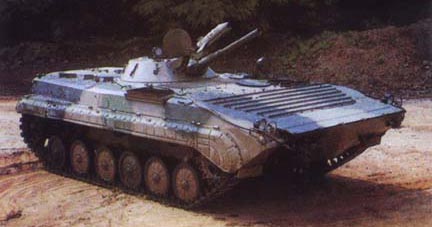
Chinese Type 86. Many were exported and the vehicle was also produced to several variants (will be a standalone subject soon).
China produced an estimated 3,000+ Type 86s, but in 2005 about 1,000 were enlisted as of 2009.
India ordered in 1982 about 350 and 700 from USSR delivered until 1989 and managed to produce under license 100 to 450. 700 are in active service currently.
Mongolia obtained 400 vehicles along with 3000 9M14M Malyutka ATGMs) from 1981 to 1985 and 310 enlisted as of 2003.
North Korea obtained 100 vehicles in 1972 from the USSR, 122 more in 1984 (1985-1991), locally known as the Korshuns (200 in service by 1996).
Others operators includes Brunei, Cambodia (70), Myanmar (50+ from PRC), Sri Lanka (12 from Ukraine in 1994), Tajikistan (40 in 1991, now 10-11), Turkmenistan (538 BMP-1/2s in 1995, 930 as of 2005, 51 BRM-1s in 1995 (12 in 2005) and now Currently 156 BMP-1s in service), Uzbekistan (180 plus 6 BRM-1s in 2005), Vietnam (150 in 1979, 600 BMP-1s enlisted in 2009 to today.
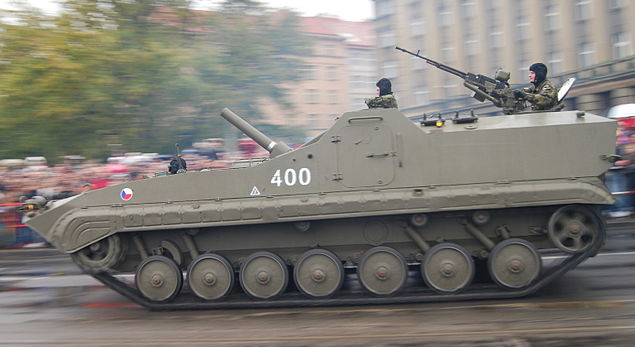
Czech 120 mm PRAM mortar carrier conversion
Europe
Most East-European countries adopted the BMP-1 (but Yugoslavia), but more surprisingly a Neutral like Sweden, NATO affiliated countries like Germany (standardized ex-East-German) and Greece (ex-German) in succession, also.Albania obtained 17 BMP-1s (ex. East German) in 1995.
Belarus had 938 BMP-1s in 1991, but 109 in 2005 and 161 BRM-1s.
Bulgaria purchased 560 total, including 100 BMP-1s in 1995 from Russia which are currently in service.
Former Czechoslovakia: 2,252 in 1973-1989 were mostly of Czechoslovak manufactured and the remnant imported from the Soviet Union).
Before the breakup of Czechoslovakia 1,006 BVP-1/BVP-1KS and 265 BPzV "Svatava" reconnaissance vehicles passed on to the Czech and Slovakian states. In addition 151 BMP-1P/c were delivered to East Germany. According to Wikipedia, as much as 18,000 were delivered by Czechoslovakia alone.
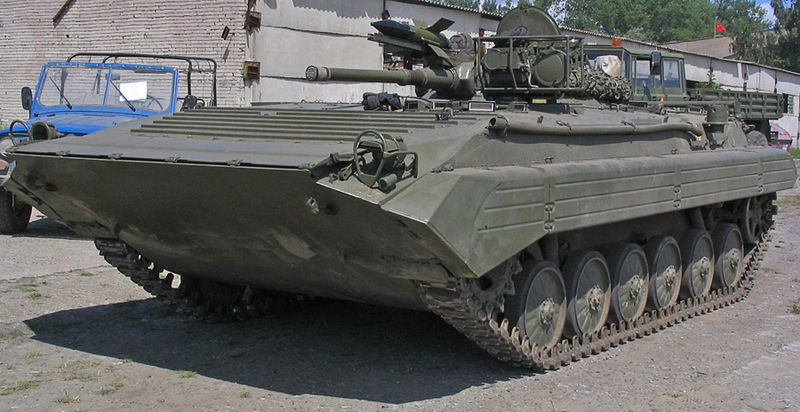
Czech BPzV-1, general appearance.
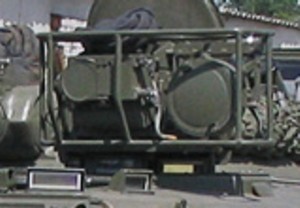
Czech BPzV-1, Svatava laser range finder detail.
In 1992 the Czech Republic had 623 BVP-1s and 145 BPzV "Svatava"s, 605 in service as 1995-96, 207 BVP-1s in 2008, placed in reserved plus 76 BPzV "Svatava"s, and 15 BRM-1Ks. Slovakia obtained 383 BVP-1s and 120 BPzV "Svatava"s but currently only 308 BVP-1s and 71 BPzV "Svatava"s.
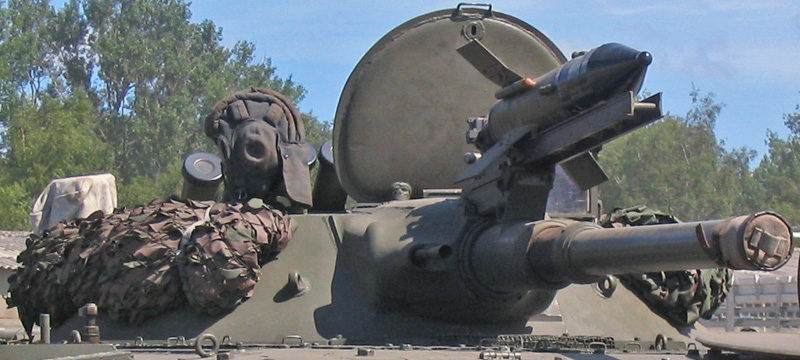
Czech BPzV-1 Svatava turret closeup.
Finland bought 195 from USSR in three batches, in 1981, 85 in 1982 (including 1Ks), and finally 110 units BMP-1/1P in 1990 from ex-East German stocks modernized in 1994–1997 by Patria Vammas Oy which also developed the BMP-1TJ "Tuija" artillery reconnaissance vehicle in service as of 1996, all withdrawn from 2005 while 50 were converted to command and artillery observing vehicles.
Greece purchased from Germany 501 BMP-1A1 Osts standardized to NATO specs (1992-1994) and later offered 500 as aid to Iraq (100 accepted as of 2005). 377 were in service in 2006 and in 2014, some received the ZU-23-2 AA mount as more conversions are planned.
Germany: East Germany ordered 1,133 BMPs in 1974 delivered by the USSR in 1974-1982 (Counting some Czech-built vehicles).
After the reunification, the Bundeswehr inherited from 850+ vehicles (chiefly BMP-1P model), modified to the NATO safety standards. Their new designation was BMP-1A1 Ost. 764 were extant in 1994, 450 in 1996, later scrapped or sold: 110 to Finland (1990), 501 to Greece (1993), to Sweden.
Hungary had 500 Soviet-built BMP-1/1Ks delivered in 1973-78 plus 2 Czech-built in 1994 and about 487 BMP-1s and 12 BRM-1Ks were enlisted as of 2007, now in reserve.
Moldova obtained 210 BMP-1/2s in 1994. Poland ordered some 1,409 BWP-1s in 1969, delivered in 1972-1979, 22 BWR-1D (BRM-1K) in 1987, 16 BWR-1S (modernized BPzV) reconnaissance vehicles (Czech) in the 1990s. Apparently 1,306 BWP-1s, 33 BWP-1Ds, 5 MP-31s and 6 ZWDSz-2s were in service in 2008.
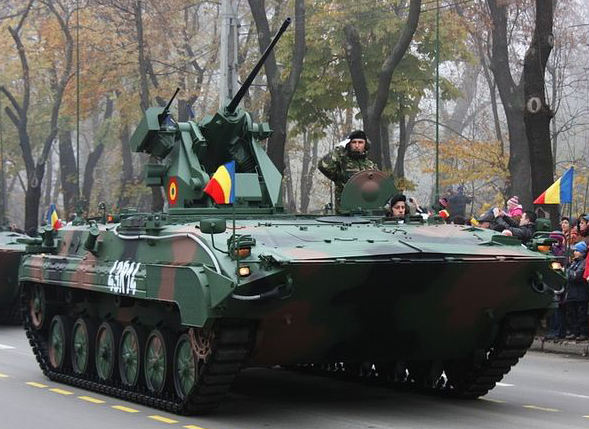
Romanian MLI-84 IFV on parade at Bucarest, Army Day.
Romania built its own variant, the MLI-84, but also operated some Soviet-made PRP-4 "Nard"s. By 2002, 177 MLI-84s were enlisted in service.
Sweden ordered 12 NATO standardized vehicles from Germany in 1993-97 for trials and ordered 360 more in 1994 (delivered 1998-2001 and modernized in Poland). They all had a third, this time Swedish upgrade as the Pbv 501A. 340 still in service in 2006 were withdrawn and sold.
Ukraine operated some 2,525 (1994) and only 1,008 in 2005 along with 458 BRM-1Ks. Some were modernized as the BMP-1U standard while other were converted into armored recovery vehicles.
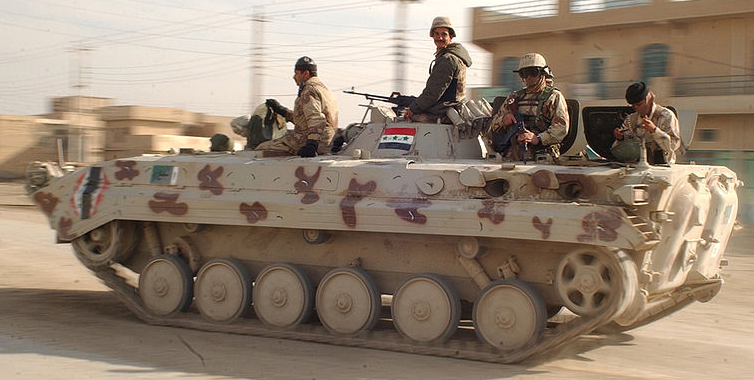
Iraqi new Army BMP-1s
Middle East
Iran post-revolution purchased 200 BMP-1 (along with 2000 9M14M Malyutka ATGMs) in 1981 from Syria. 400 more were obtained from USSR (Czech-built) in 1986, delivered until 1989, and some Chinese Type 86s were purchased. 200 were estimated in service in 1996. But Iran also produced from 1997 some 80 Boragh IFVs (2001-2008), and 140 APC versions in 2005-2008.Iraq ordered 200 vehicles in 1973 from USSR (delivered 1974-1975) with 750 more in 1981 (Czech-built, delivered 1981-1987), plus some Chinese Type 86s. 1,500 BMPs were in service in 1990, 900 in 2002. The Iraq new Army acquired 100 BMP-1A1 Osts from Greece in 2005 plus and 110 from Ukraine (2007). Nowadays, 434 BMP-1s of all types would be active.
Israel had some captured during the Yom Kippur War in 1973, some being converted as mortar carriers.
Lebanon was a Former operator, with machines provided both by Syria and USSR (on loan) 1983-1990 (to the Druze Progressive Socialist Party militia).
Syria acquired some 170 BMP-1s just before the 1973 Yom Kippur War. In 1977, 2,300 were purchased from Soviet Union (delivered 1977-1989) of which were an estimated 2,100 were still active in 2005. Today, after years of civil war, these numbers probably had dwindled down around 1,900 or less.
Influence and conclusion
Due to a production almost as important as the T-54/55 and above most Soviet MBTs, and with an unclear duty/status at the origin, the Infantry Fighting Vehicle as we known it conquered the world and made its way in all modern armies, triggering dozens of copies and responses worldwide, starting with NATO. Most IFVs came of age in the 1980s, but the concept is now widely accepted. Less labor-intensive or technologically on the edge as a modern main battle tank it became a solution more appropriate the asymmetric warfare of the XXth and early XXIth century, a versatile compromise which also replaced the light tank concept.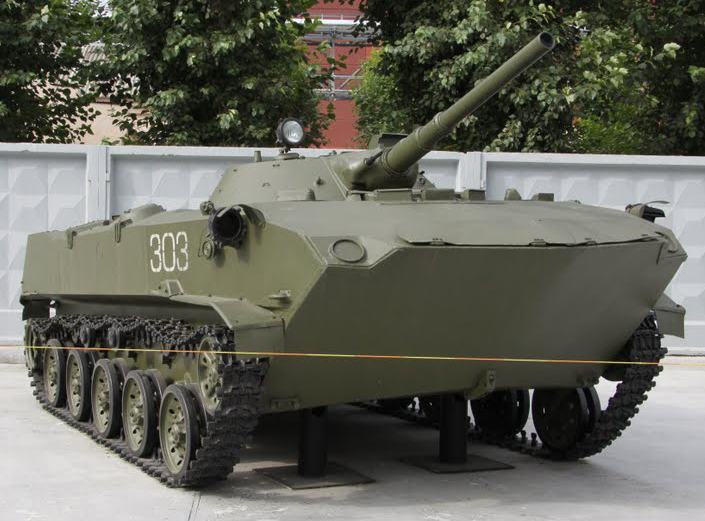
The BMD-1, here preserved at the Verkhnaya Pyshma Museum, is basically an airborne BMP-1.
BMP-1 related links & sources
The BMP-1 on WikipediaOperators
Variants
Service History
On inetres.com
BMP-1 Walkaround photos for modellers
"BMP Infantry Fighting Vehicle 1967-94" By Steven Zaloga, Peter Sarson
BMP-1 specifications |
|
| Dimensions (L-w-h) | 6.73 x 2.94 x 2.07 m (22.1 x 9.8 x 6.9 in) |
| Total weight, battle ready | 13.2 Tons (26.400 lbs) |
| Crew | 3+8 (Cdr, driver, gunner, 8 infantry) |
| Propulsion | UTD-20, V6 wc multifuel 15.8L diesel 300 hp (224 kW) 2,600 rpm pw 22.7 hp/t |
| Suspensions | Torsion bars, shock absorbers |
| Speed (land/x-cty/water) | 65/45/7 km/h (40/28/4 mph) |
| Range (road/off road) | 600/500 km (370/310 mi) 462 gal. |
| Armament | Main: 73 mm 2A28 Grom lpsb semi-auto 40 rds ATGM launcher for 9M14 Malyutka (4 rounds) Sec. PKT 7.62 mm (0.3 in) LMG, 2000 rounds |
| Armor | 6 to 33 mm (0.24-1.30 in) |
| Total production (USSR alone) | Approx. 20,000 |
Soviet/Russian variants

BMP-1 (Ob'yekt 765Sp1 which stands for spetsifikatsiya – specification), first pre-production vehicle in testings, 1964. Note the absent side skirts. It had a shorter nose section than the prototype and a larger angled plate, swim vanes modified, raised fender profile, fume extraction ports moved outwards, twin torsion bar spring for the rear roof troop hatches and moved firing ports higher up in the armour plates. This model 1966 was built until 1969.

BMP-1sp2 (NATO model 1970), standard production of a rifle motorized brigade, fall early 1970s. This was version was produced until 1973. Roomier, with an elongated nose section, raising circular telescopic snorkel, rearranged roof hatches, front left side air intake removed, NBC filter cover and new PKM port.
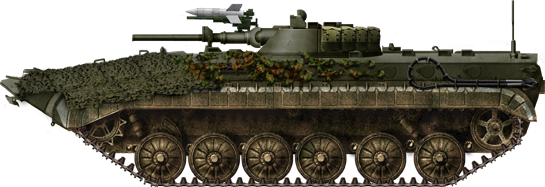
Soviet BMP-1 model 1973 with camouflage nest in exercises (Ob'yekt 765Sp2), fall 1970s. Assimilated as the model 1973 with the sp3 by NATO, but the first version inaugurated a whole series of novelties, from the semi-automatic 9S428 ATGM guiding system and gun stabilization, improved NBC, engine, autoloader, and improved vision devices.
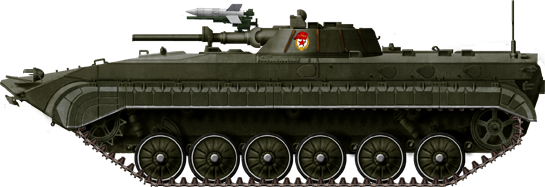
Camouflaged BMP-1 model 1973 (Ob'yekt 765Sp3), in may parade colors. The sp3 introduced a new OG-15V HE-Frag round in its ammo supply and the accompanying 1PN22M2 sight, a modified traffic signal system some additional protection and the 3 autoloader removed; It was 200 kgs heavier and was known by NATO as the BMP M1976.

BMP-1M "Shkval", the Ukrainian modernized version of the BMP-1M fitted with 2x3 81 mm 902V "Tucha" smoke grenade launchers at the rear of the turret. The designation was never official, only used by NATO. It was preceded by the MP-1 M1979/1 (Ob'yekt 765Sp8), sometimes designated by NATO BMP-1G, armed with a 30 mm AGS-17 "Plamya" automatic grenade launcher.
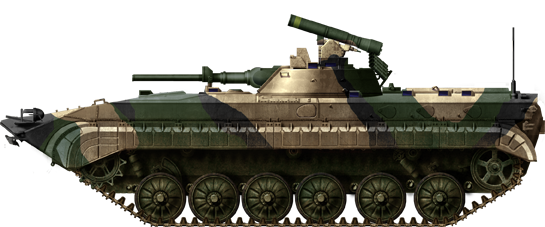
BMP-1P or M1981 (Ob'yekt 765Sp4). 9P135M launcher with semi-automatic control for SACLOS 9M113/M "Konkurs" ATGMs, or 9M111 "Fagot" and "Fagot-B", new improved NBC lining, new automatic fire extinguishers, additional machine gun firing ports (left side of the hull, front of the turret). 9M32M "Strela-2M"/ 9M313 Igla-1 or MANPADS. Produced from 1979 to 1983.

Soviet BMP-1 with partial add-on protection in Afghanistan, 1980s. Many damaged and recovered BMP-1s were converted back as BMP-1D, th so-called "Afghan variant"; Produced from 1982 this assault version (hence the "D" for "desentnaya") had add-on armour on the sides, armoured panels protecting the suspensions, add-on armour behind the commander and driver's seats, additional troop's rood hatches pistol ports and a Plamya grenade launcher.
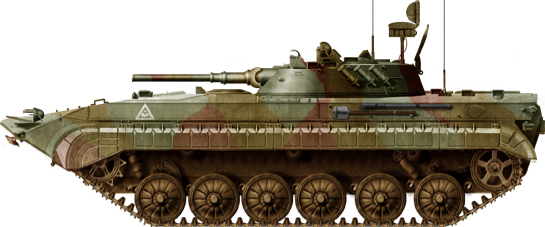
BMP-1K (Soviet command version). (The "K" stands for komandirskaya or command). Developed in 1972 it kept its standard armament but the troop compartment houses field tables and map boards and seating for three officers. Additional antenna, R-123M and R-111 radios, GPK-69 navigation system. Firing ports welded shut. Optional GLONASS navigation system. (NATO designation M1974). Three known sub variants K1/K2/K3 Platoon/Company/Battalion with variation in radio equipments.
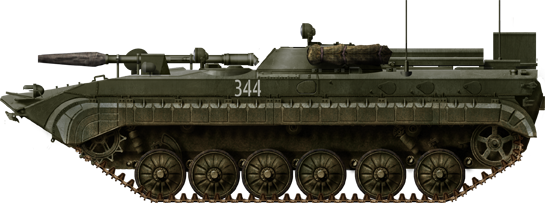
Soviet BMP-1KSh ("KSh"stands for komandno-shtabnaya – command and staff) (NATO M1978), motorized rifle/tank regiment. It was given a TNA-3 gyroscopic navigation, 2 R-111, 1 R-123MT,1 R-130M radios, field telegraph/telephone. Armament replaced by the AMU "Hawkeye" telescopic mast and its right rear hull tubular case (10 m when up) plus fixed turret. There was also an AB-1P/30 1 kW box-shaped portable petrol-electric generator (center rear hull roof replacinf the outer hatches) plus four whip antennas. 13 tonnes, crew of 3 + 4 operators armed with a single 7.62 mm PKT.Pproduction start in 1976, in action in Afghanistan and Chechnya.

BRM-1 (Ob'yekt 676) reconnaissance variant (1972)(NATO BMP-R/BMP M1976/1). It was equipped with an extensive electronic reconnaissance equipment. Conversion performed at the Chelyabinsk Tractor Works (ChTZ) fall-1960s to early 1970s and continued by the Kurgan Engineering Works (KMZ). Extra-wide, low-profile, two-man turret moved to the rear of the hull generally withou the ATGM launcher, two small roof hatches, PSNR-5K (1RL-133-1) "Tall Mike" telescopic ground surveillance radar (housed in the turret's rear), 1D8 laser rangefinder, TNA-1/3 gyroscopic navigation systems (with coordinates recorder) plus additional R-123M, R-130M, R-148 and R-014D radios (range up to 50 km to 300 km with the radio mast). The radar, had two modes, terrain survey and target tracking, and can detect vehicles up to 7000m or personnel up to 2000m around. A doppler radar for range calculations was installed from 1993 onwards. Tactically, one was assigned pere recce company. Some had in addition 2x3 81 mm 902V "Tucha" smoke grenade launchers.

Soviet PRP-3 "Val" (NATO M1975) artillery reconnaissance vehicle. Also known as the (Ob'yekt 767 1ZhZ) (PRP stands for podvizhnoy razvedyvatel’niy punkt or mobile reconnaissance post) and sometimes BMP-SON.. Production started in 1972 (Kurgan Engineering Works) and 1979 (Rubtsovsk Engineering Works) and it received two R-123M or R-108 radios, optical devices for artillery/guided missile target indication, adjustment and target locating. Just one PKT machine gun was ball-mounted in front of the large flat two-man turret which cover the first rear hatches. This turret had two forward-opening hatches with periscopes for observation and optics. The right hand side of the turret was given a huttered optic. 1RL126 "Small Fred" counterbattery and surveillance radar was mounted in a circular hatch cover located rear left of the turret. It operated in the J-band with a 20 km detections range, 7 km tracking range. This equipment was completed by 1V44/1G13M/1G25-1 navigational systems, 1D6/D6M1 laser rangefinder, 10P79 vision device, 1PN29 night vision device and 90 mm 2P130-1 launcher (20 9M41 illumination missiles). The crew of 5 manned the vehicle, affected to artillery/guided missile battalions and the target acquisition battery of an artillery regiment.
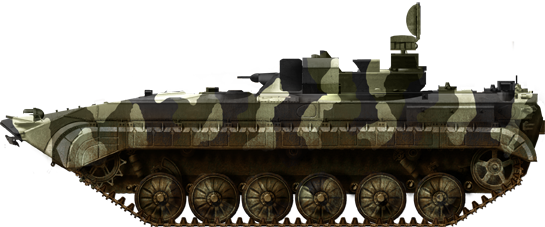
Russian PRP-4 "Nard" (Ob'yekt 779, 1V121). Modernized version of the latter, which entered service in the 1980s. Equipment comprised the 1A30M and two R-173 radios, 1G25-1/1G13/KP-4 navigational system, 1D11M-1 active pulsed laser range finder, 1PN59 thermal vision, 1PN61 active pulsed night vision. The radar was also upgraded, to an 1RL-133-1 "Tall Mike" retractable battlefield surveillance radar. Optical devices located either side sof the turret received protected mountings. In addition new electronic data processor and ann auxiliary power supply were mounted. It was produced by the Rubtsovsk Engineering Works. Later on which procuded the PRP-4M "Deyteriy" (1988) which was given a 1PN71 thermal IR vision device (3,000 m range), 1D14 periscopic laser rangefinder, 1D13 portable laser reconnaissance device and a turret antenna mounted behind the radar hatch. The PRP-4M "Deyteriy" was also sometimes given a fake gun mantlet and offset gun barrel to look like a BMP-2. The latest upgrade was the PRP-4MU which had an 1RL-133-3 retractable battlefield surveillance radar (12,000 m range), 1D14 periscopic laser rangefinder (10,000 m range) and T-235-1U data transmetter. This upgrade started in the late 1980s and the vehicle is used at regimental level.
Warsaw Pact and other users
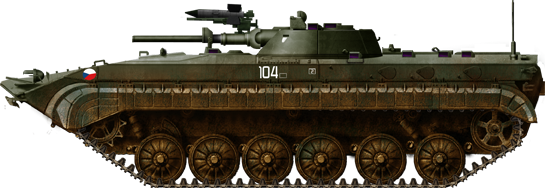
Czech BVP-1 (licence-built) VOP 026 Excaliburarmy.
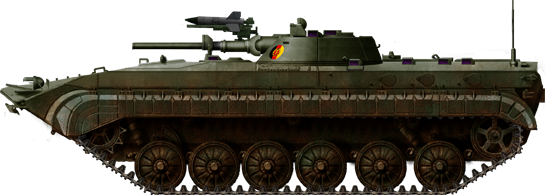
East-German BMP-1 - 1,133 were ordered in 1974 and delivered between 1974 and 1982 (some Czechoslovakian-built)
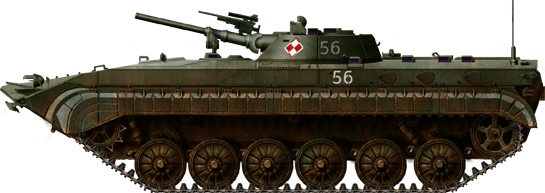
Polish BMP-1, 1970s
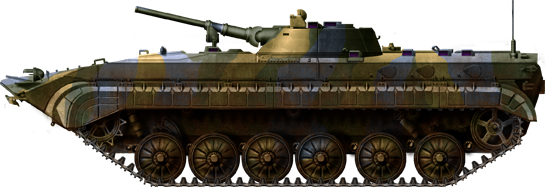
Syrian BMP-1 captured in 1973 and now displayed at the Latrun museum
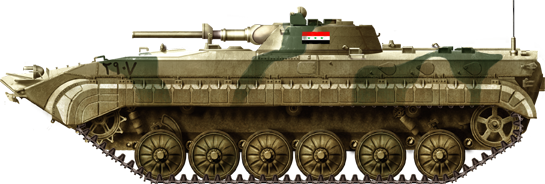
Iraqi BMP-1 in the Iran-Iraq war of the 1980s.
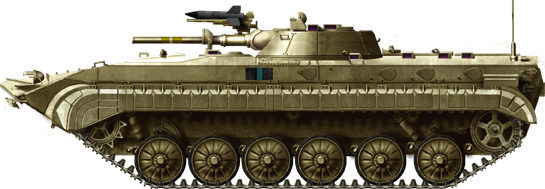
Iraqi BMP-1 of the Mechanized Regiment, 6th Armoured Brigade, 3th Armoured Division "Saladin", Kuwait 1991.

Ukrainian BMP-1, 1990s.
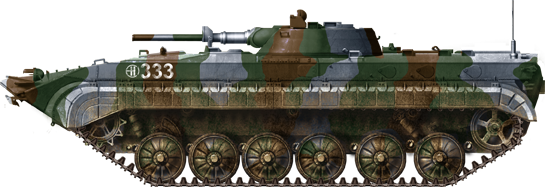
Georgian BMP-1, 2000s. These have seen extensive action against muslim guerilla fighters until recently.
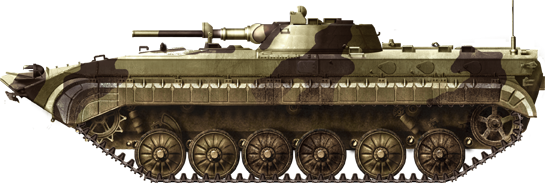
Iranian BMP-1. A local version is produced since, the Boragh, which came in multiple confirgurations.

Iraqi's Republican Guards BMP-1 in 1991.
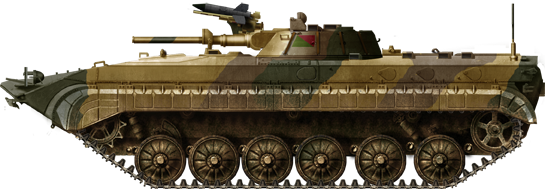
Egyptian BMP-1 of the 4th armoured division, Sinai front, Yom Kippur war 1973.
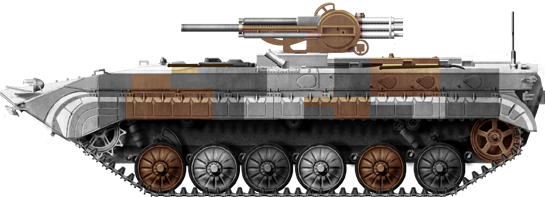
Kazakhstan modified BMP-1 fitted with a 2B9M Vasilyok 82 mortar.

Syrian BMP-1 recently photographed, 2014, Syrian civil war.
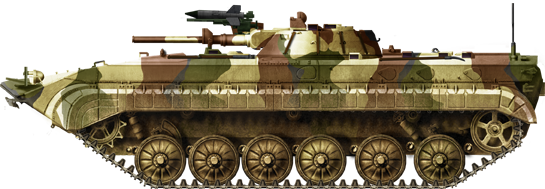
BMP-1 Azerbaidjan Army - camouflaged inspired by the BMP-2 in Azeri service.
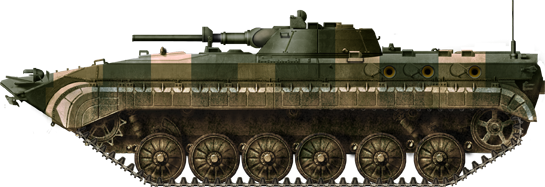
BMP-1, Morocco ground forces.
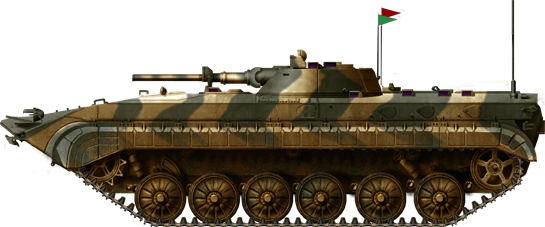
Indian BMP-1. From 350 to 700 has been ordered in 1982, delivered until 1989, while some 100 to 450 were produced and currently less than 700 are in active service or reserve. Since replaced by the BMP-2 "Sarath" locally produced under licence.
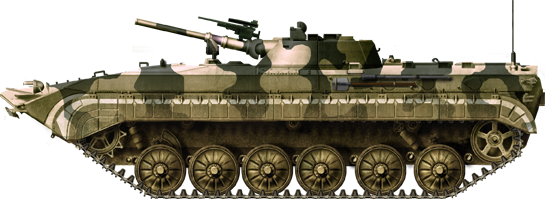
Lybian BMP-1. Many were captured by the Saharan insurgents and later passed onto the US Forces for analysis.
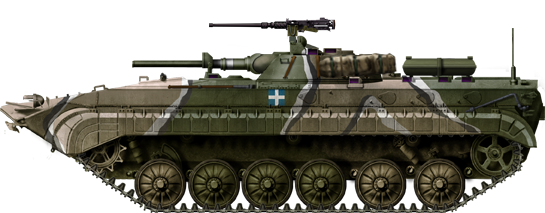
Greek BMP-1. These were former vehicles from West Germany, reconditioned to NATO standard.
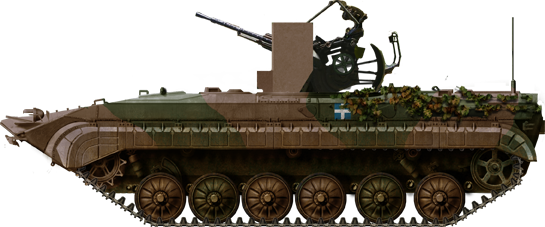
Greek BMP-1/Zsu-23-2 SPAAGs. Conversions started in 2014 and are ongoing.
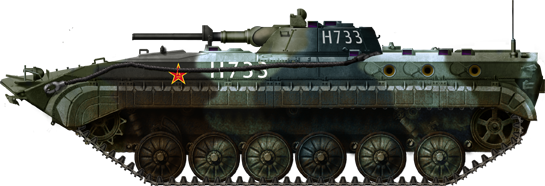
Type 86 IFV, a Chinese reversed engineered version of the BMP-1. First tests in 1986, production started in 1987. About 1,000 to 3,000 (based on the same chassis) produced, it entered service in 1992 and has been largely exported since.
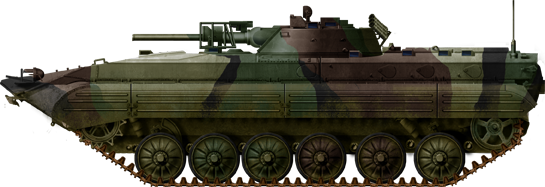
Slovakian BzVP-1.
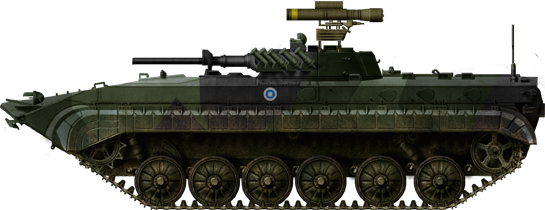
Finnish BMP-1FI, a local variant of the BMP-1P.
Gallery
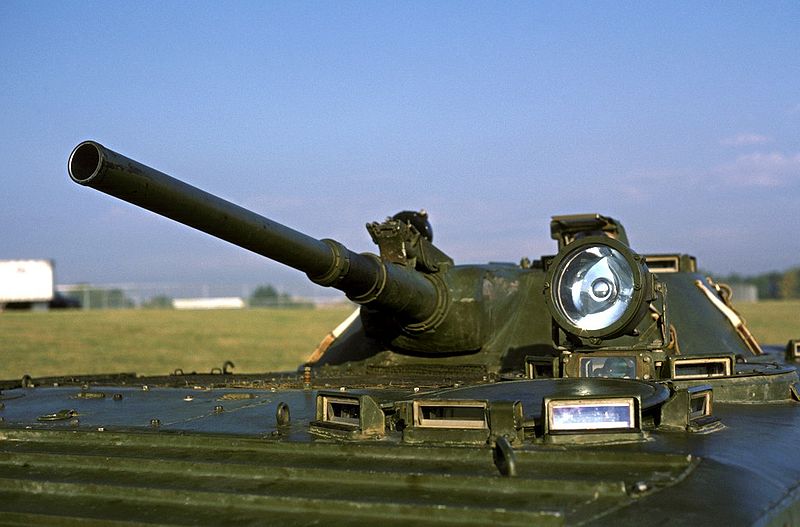
BMP-1 turret for tests at Bolling Air Force Base
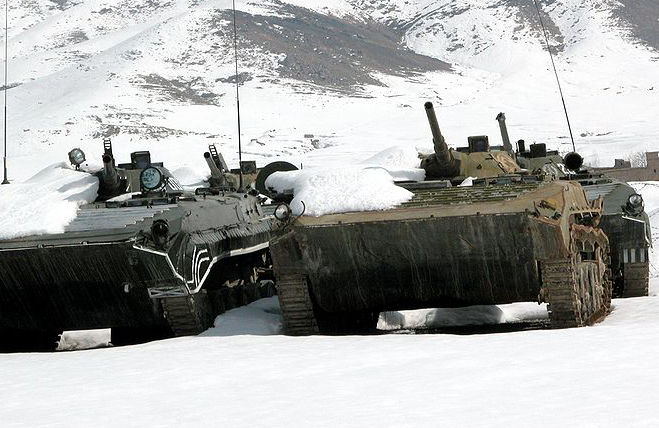
Afghan BMP-1s and some converted to SPAAGs.
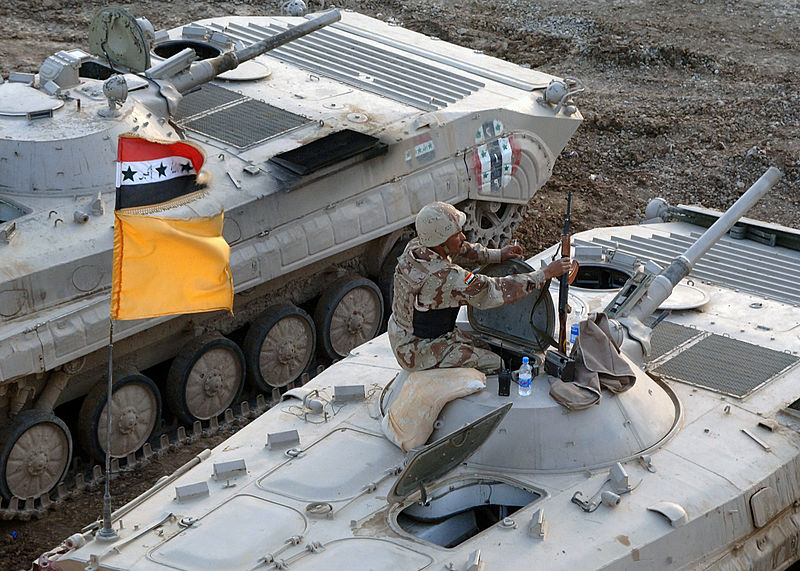
New Iraqi Army BMP-1s. About 343 are in service today, many of which are ex-Greek, ex-German "Ost" vehicles NATO standardized.
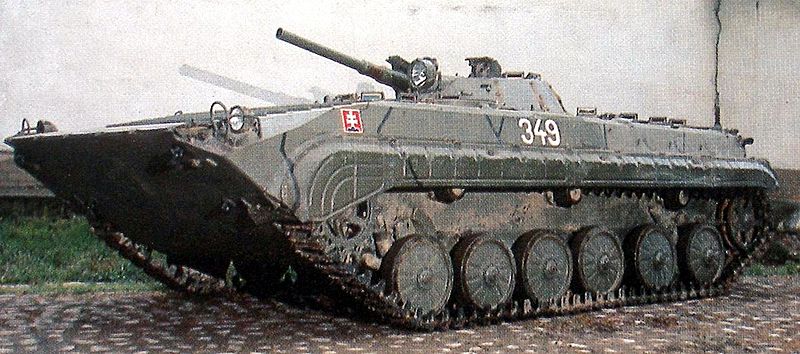
Slovakian BVP-1.
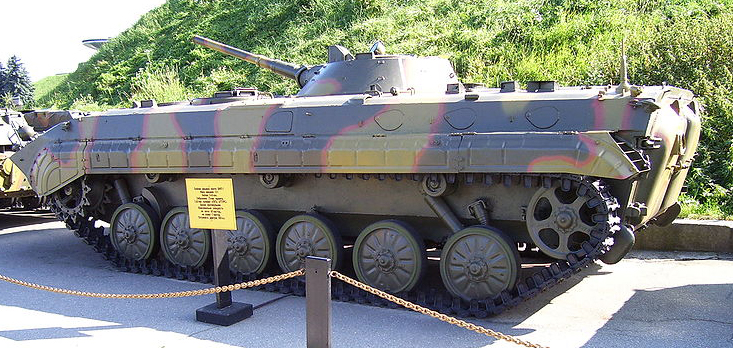
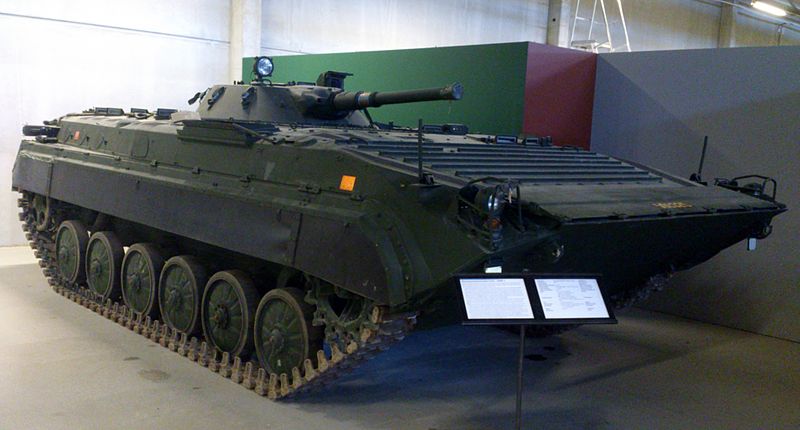
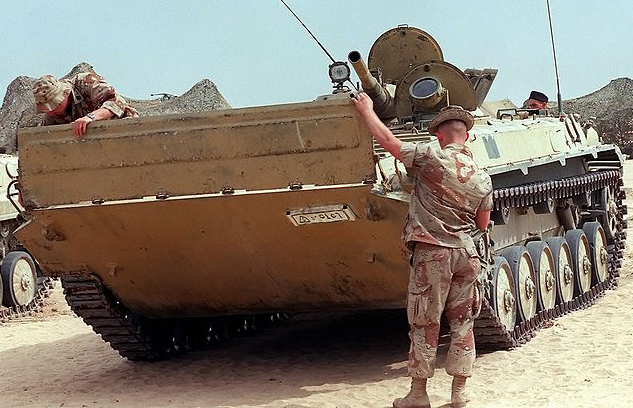

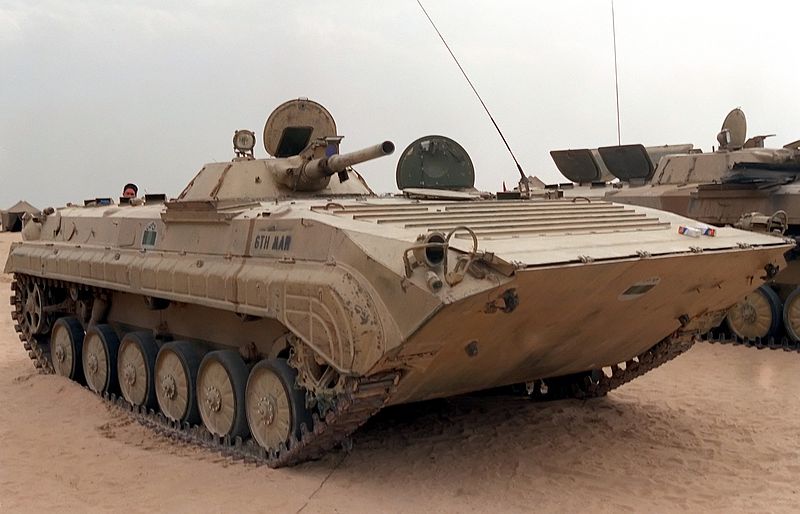
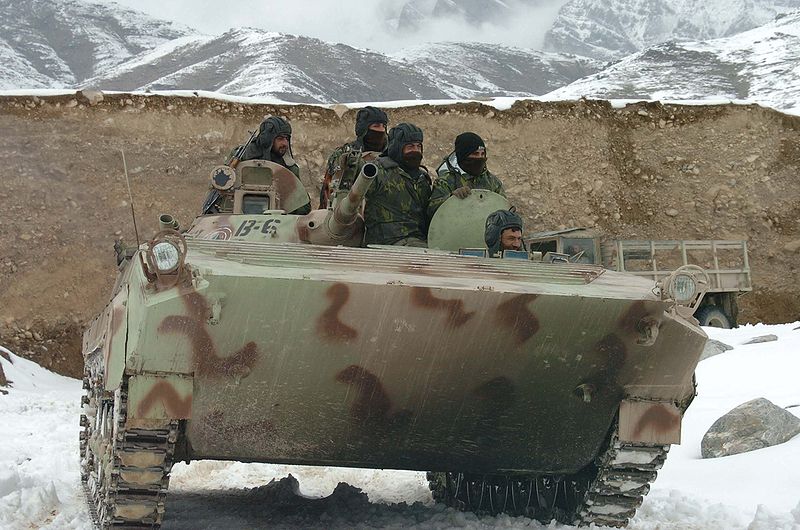
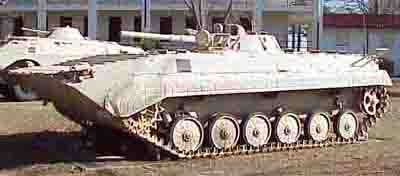
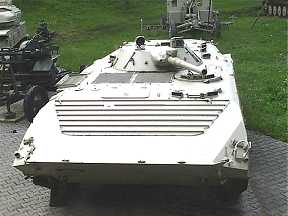

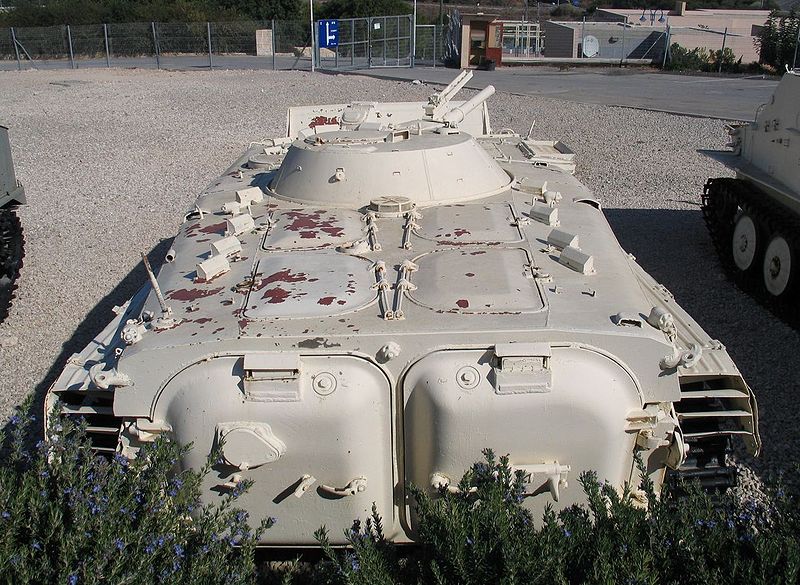
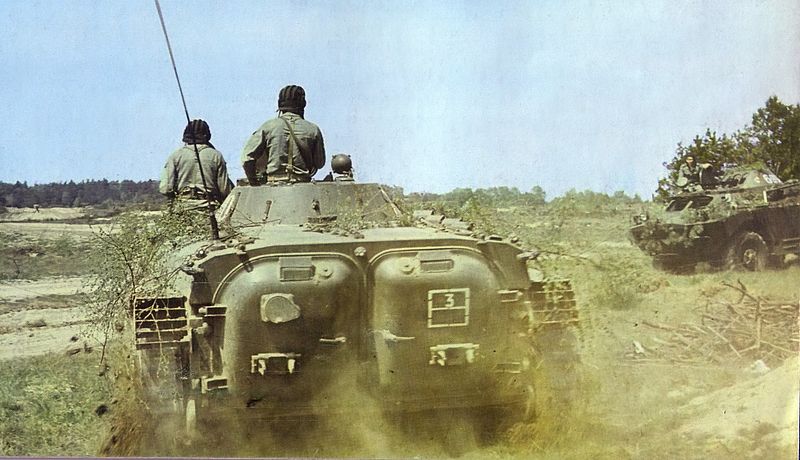
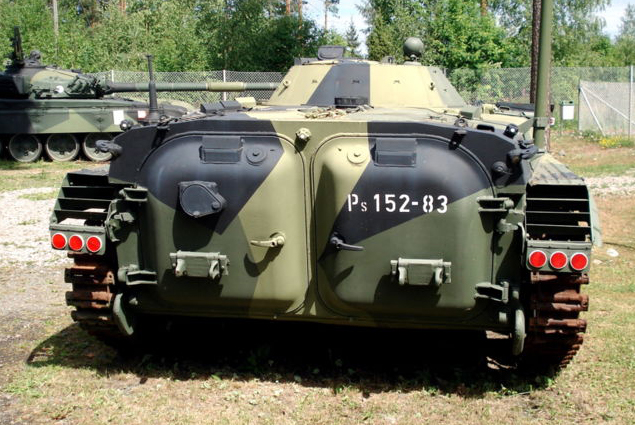
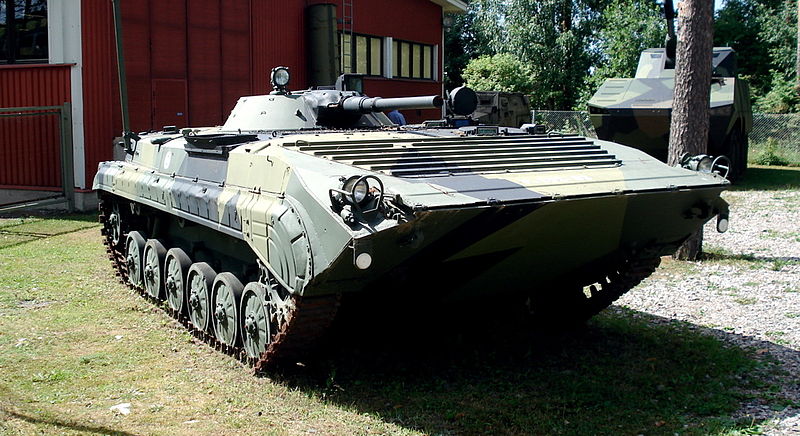
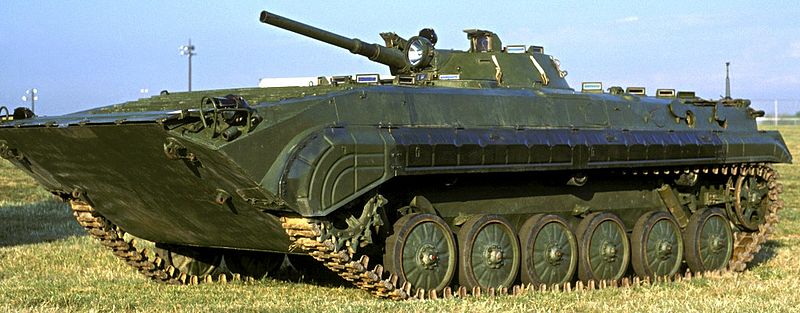
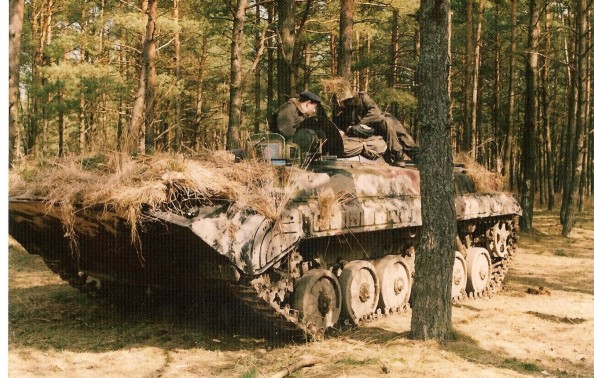
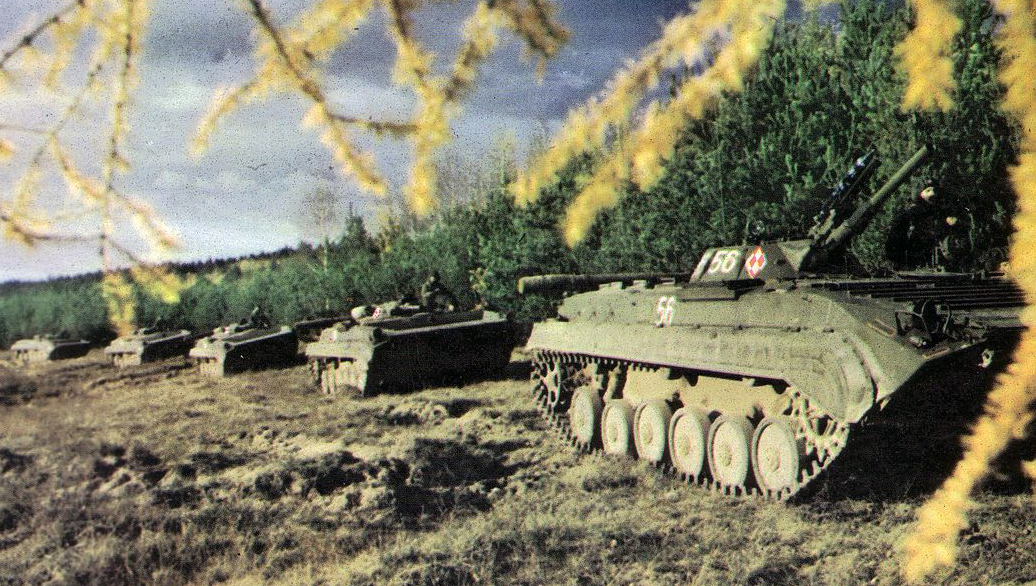
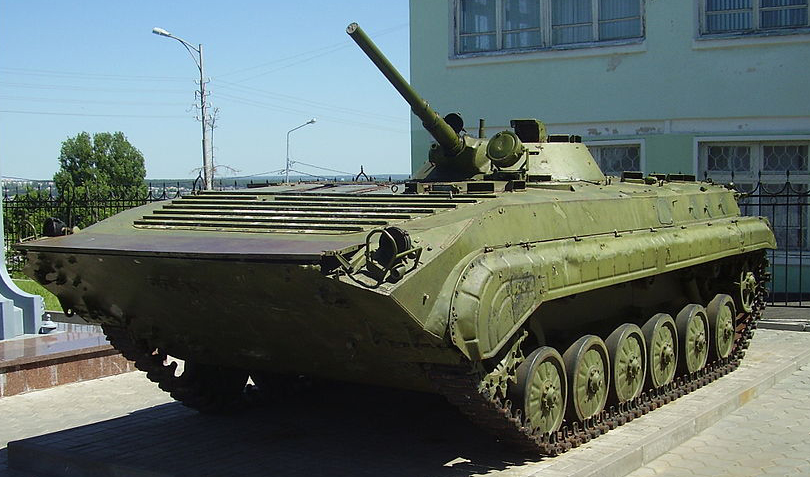
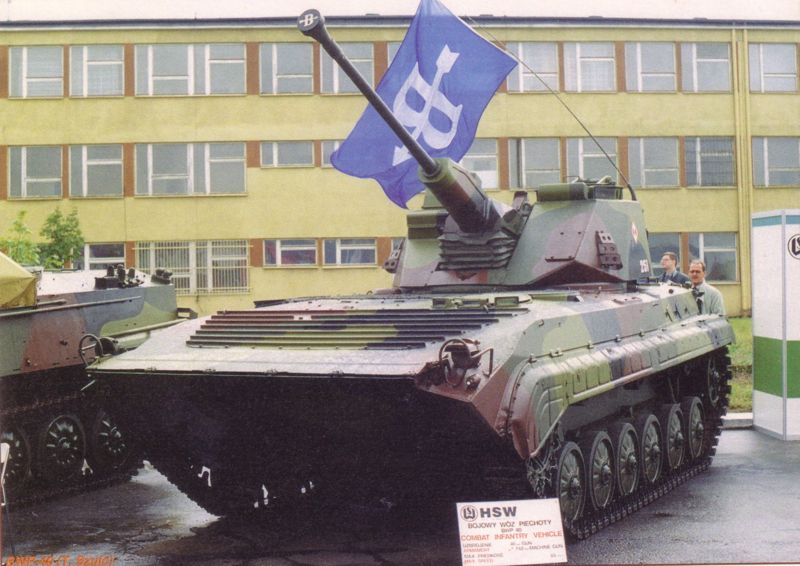
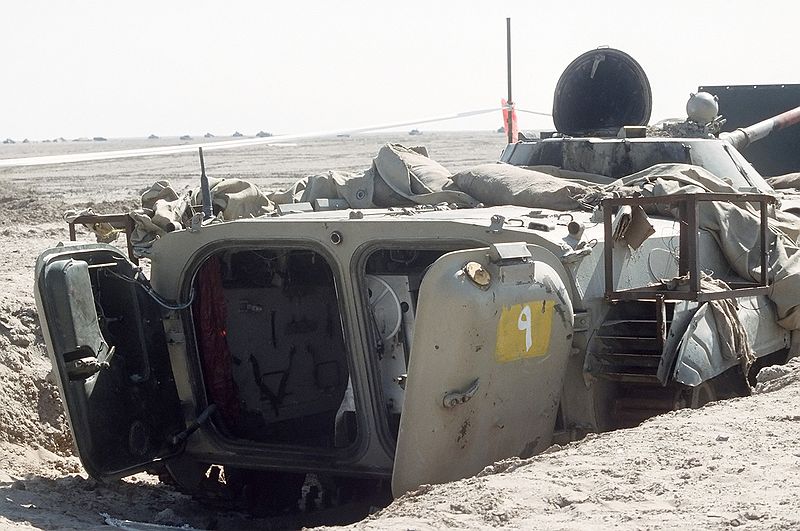
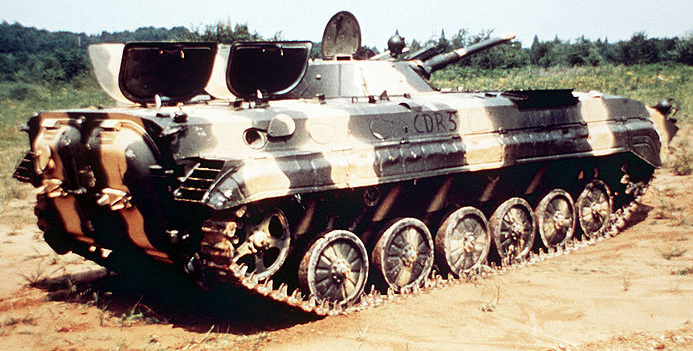
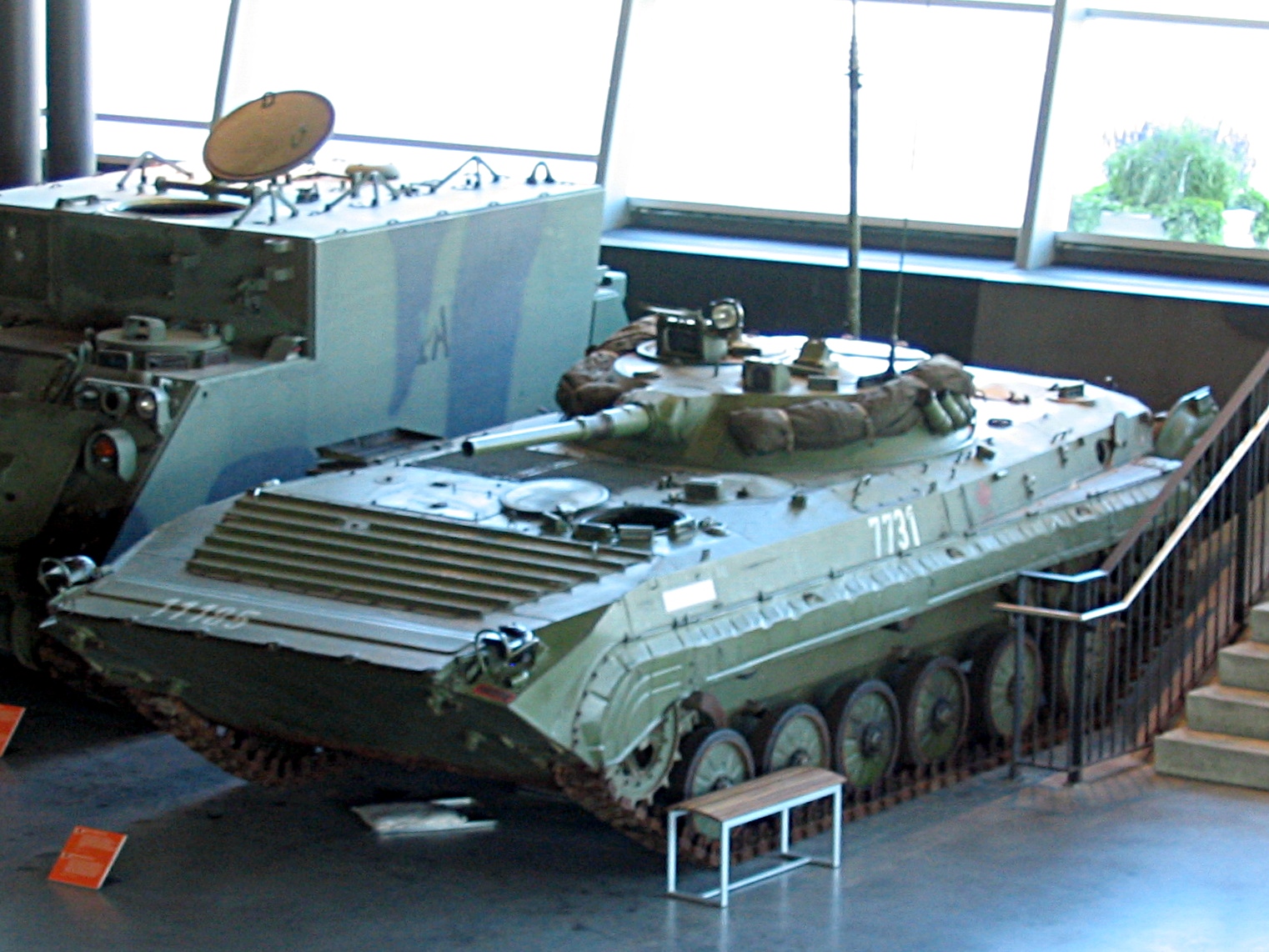
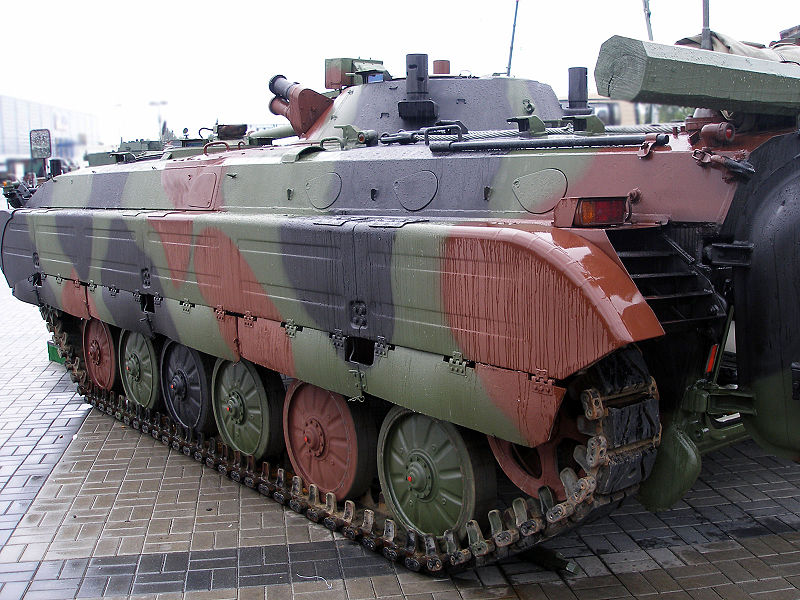
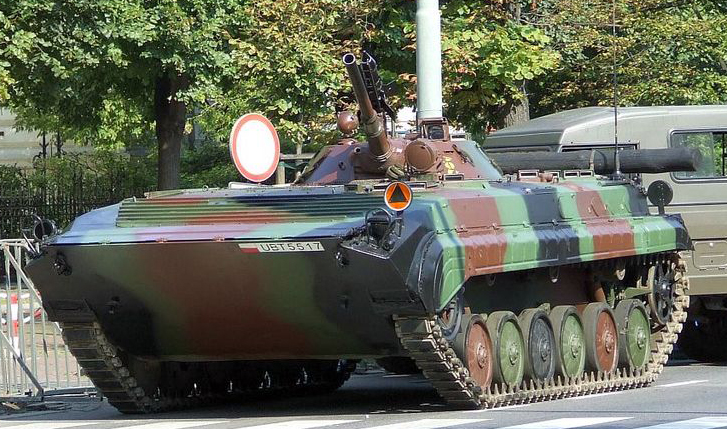

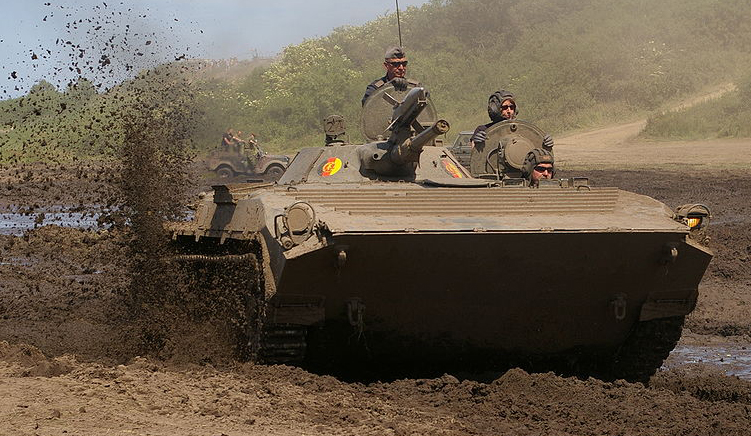
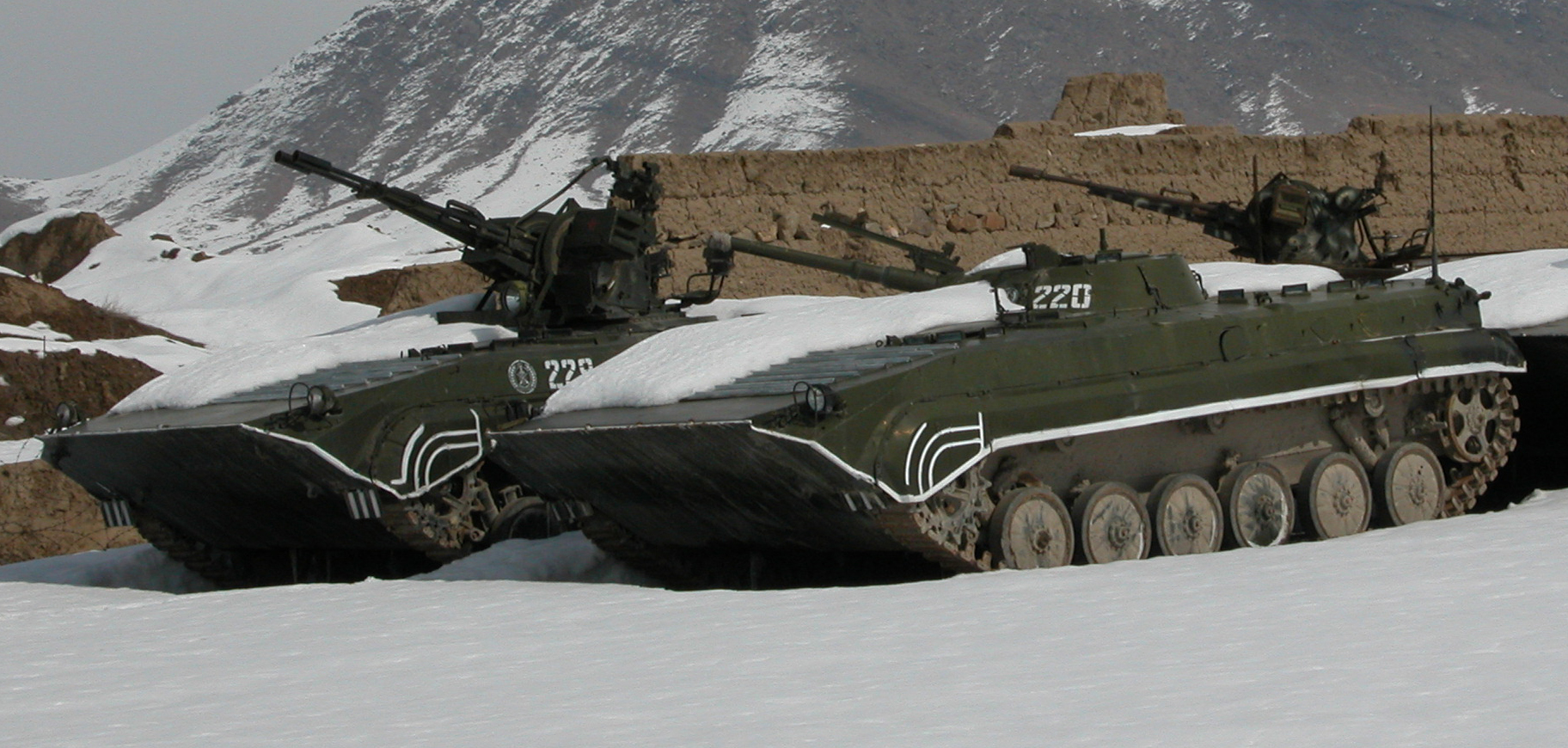
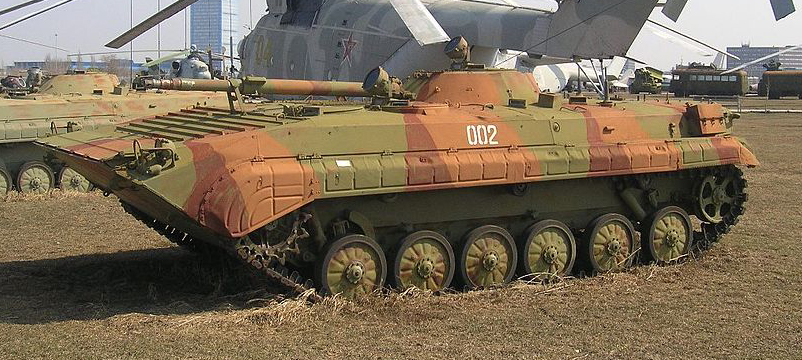
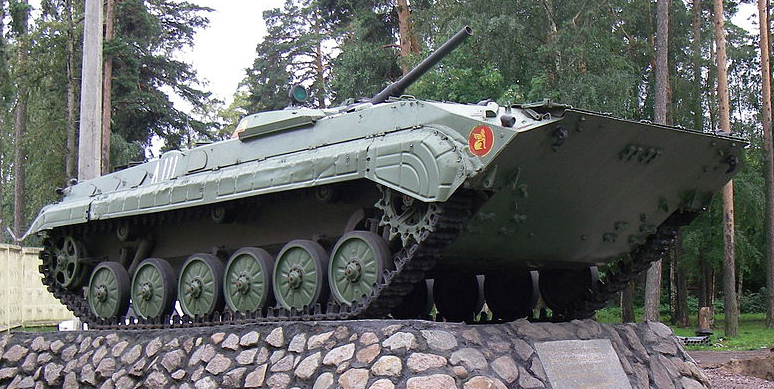
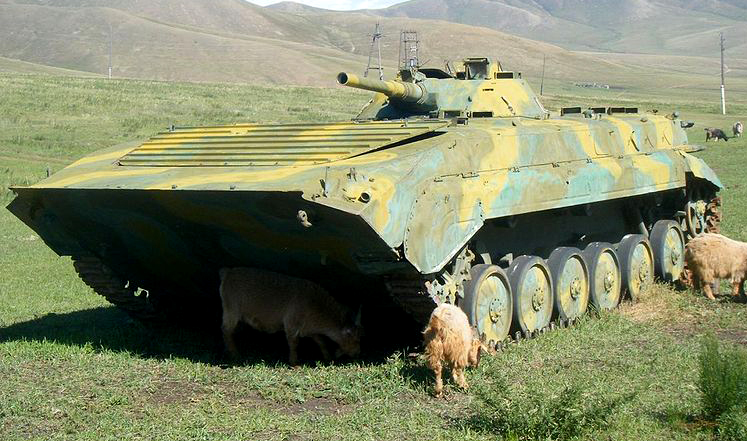
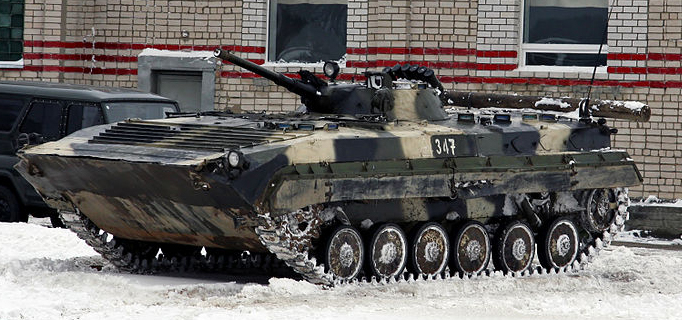
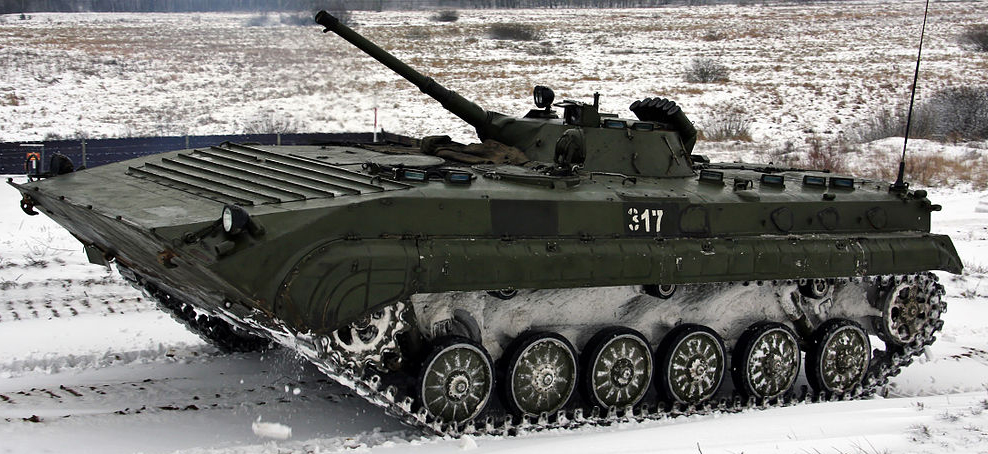
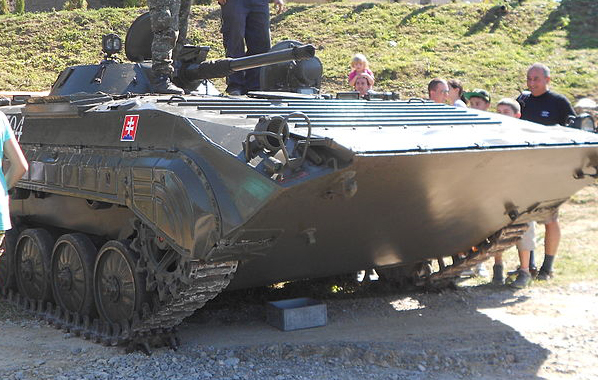
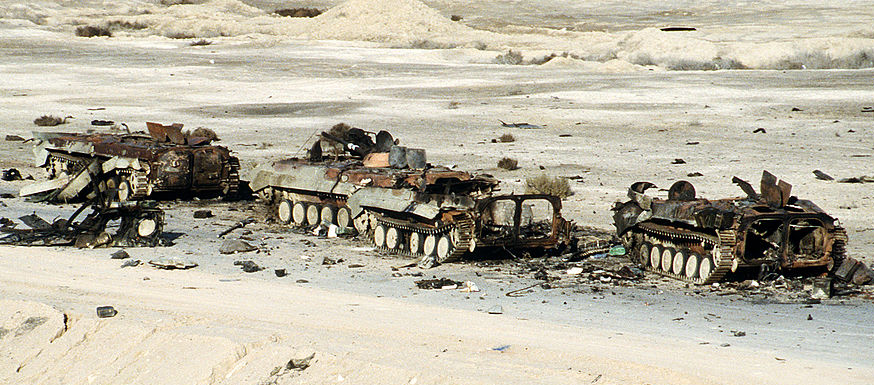
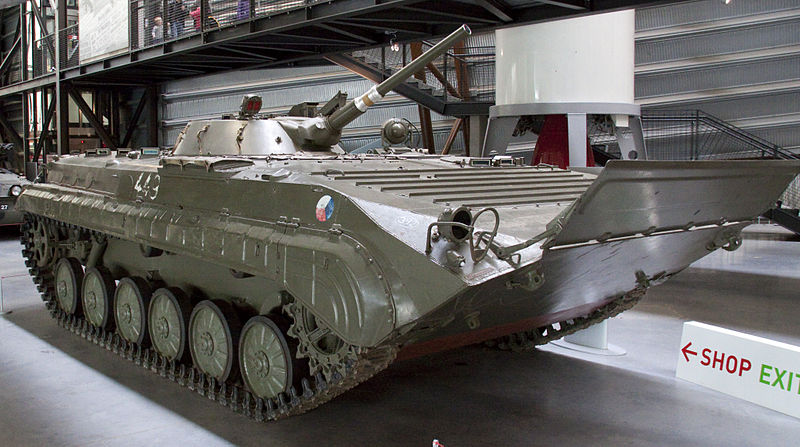
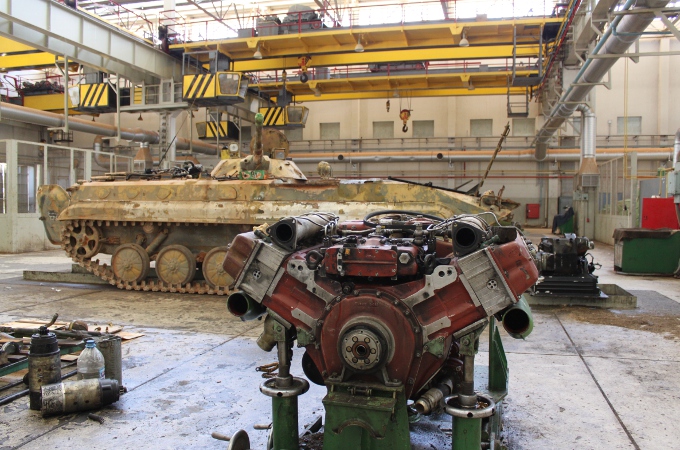

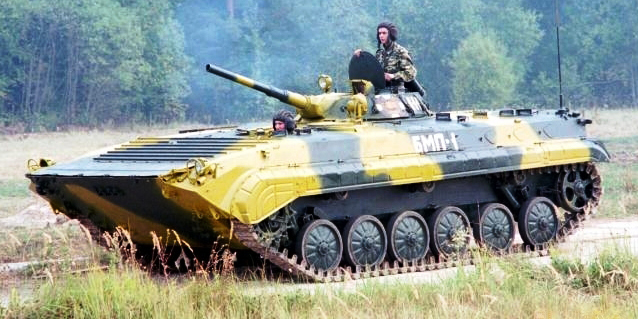
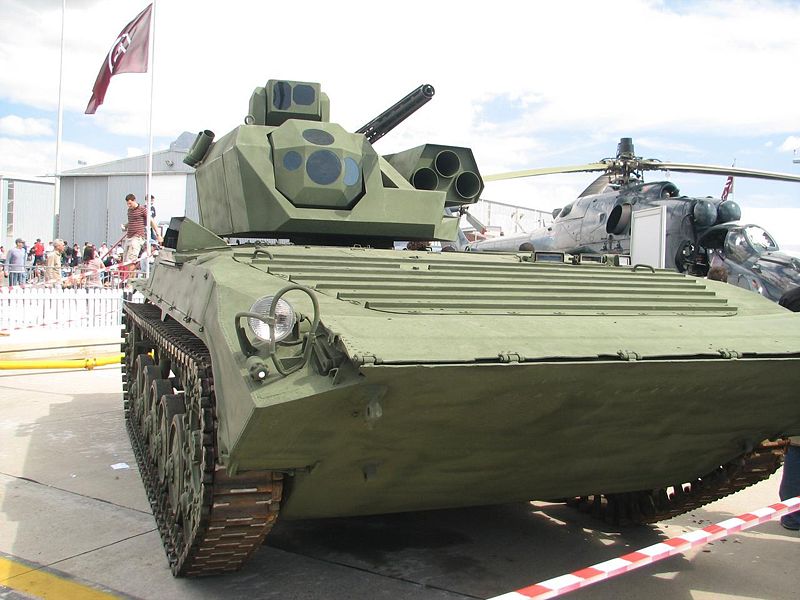
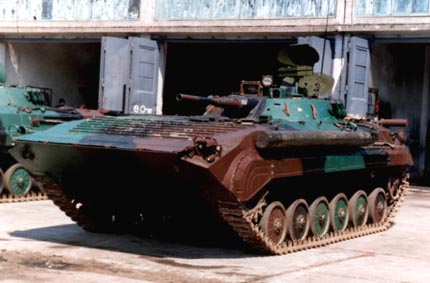
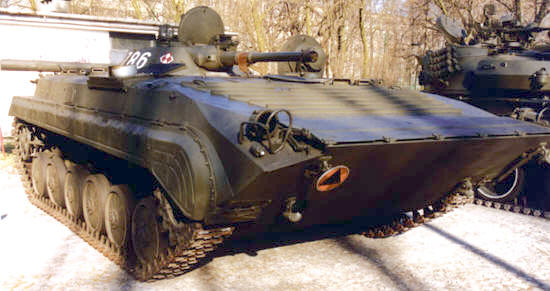
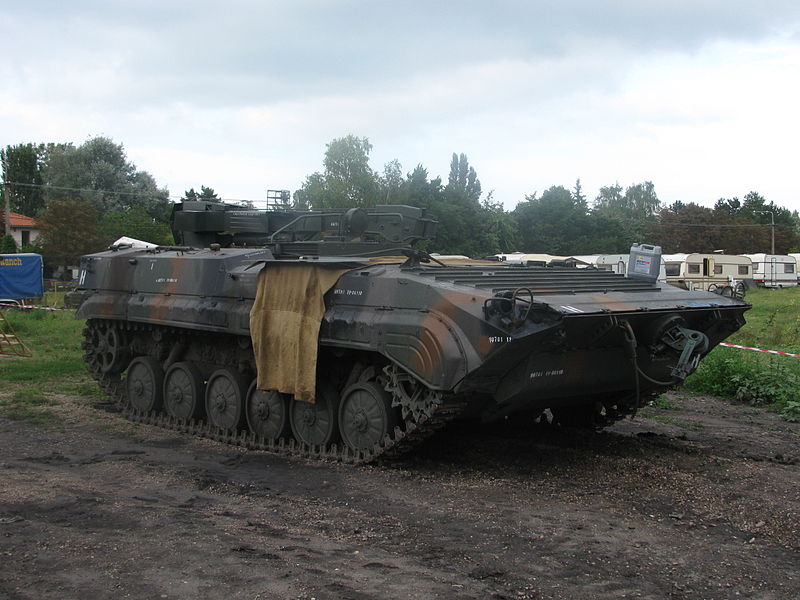
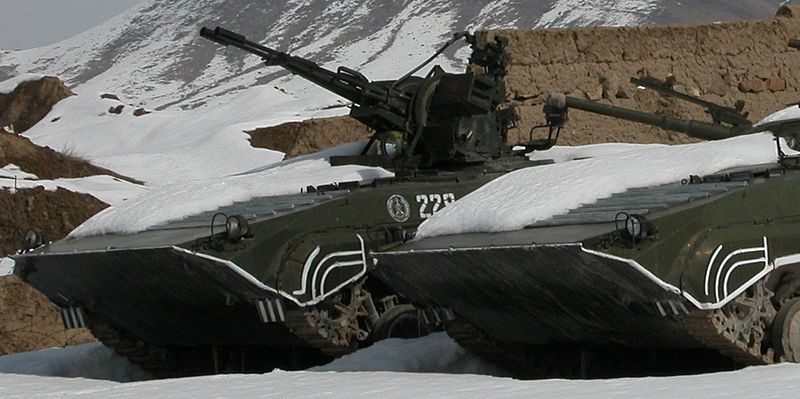
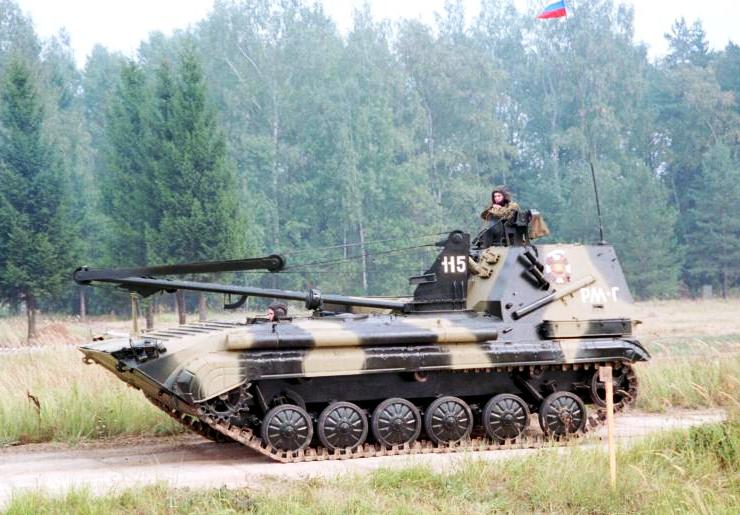
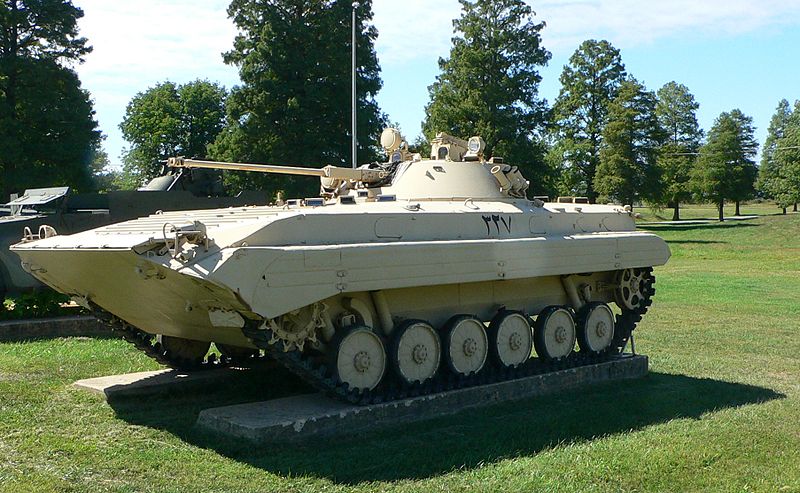
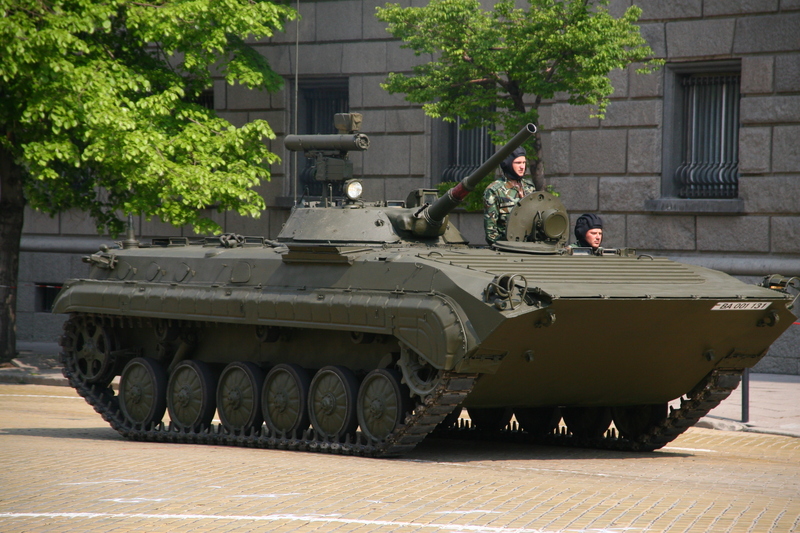
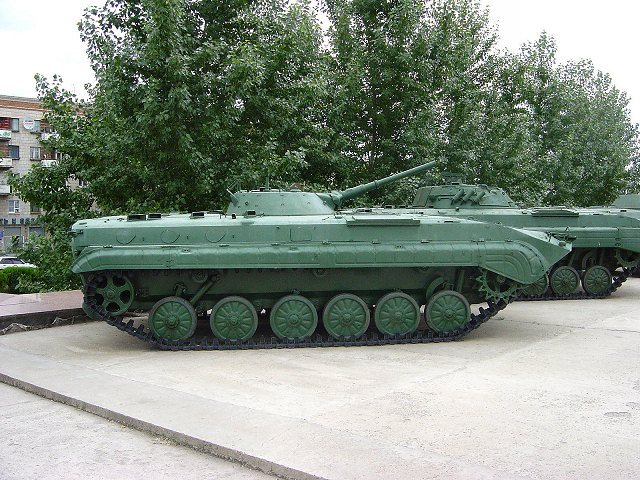
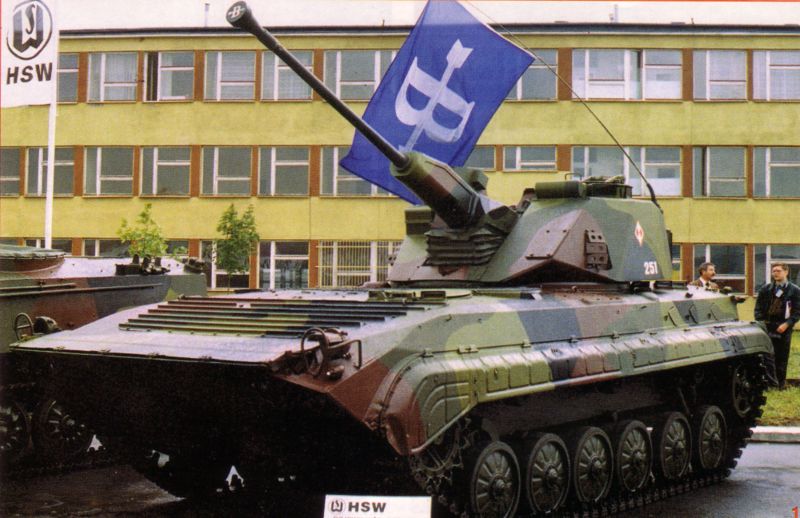
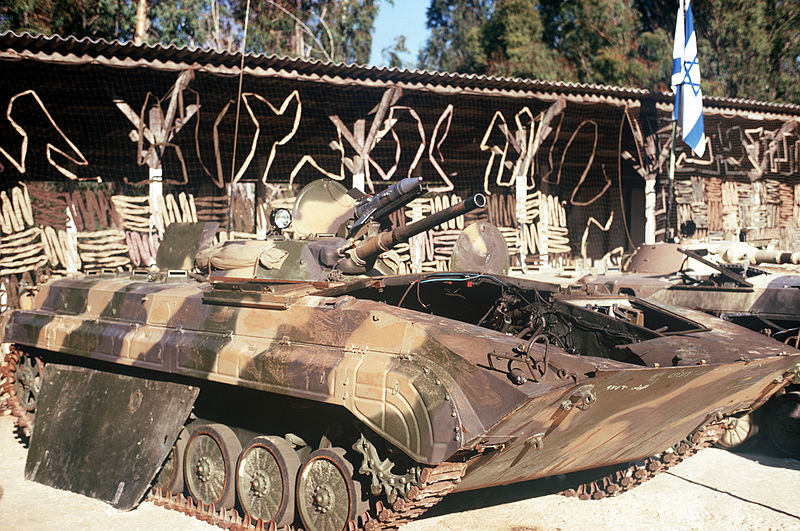
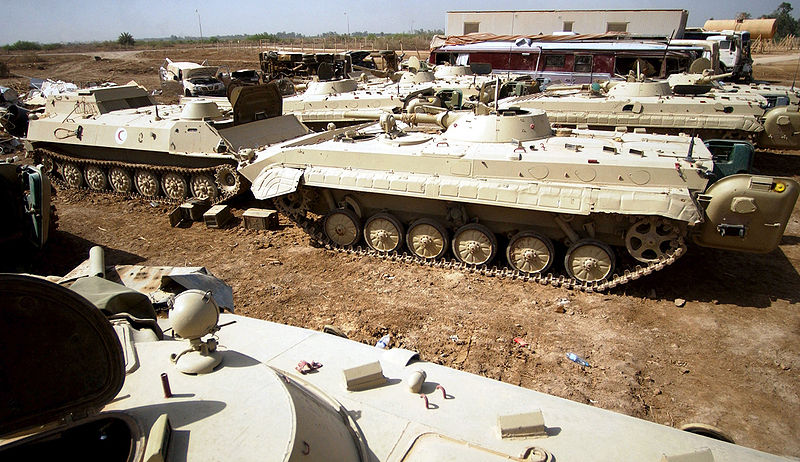
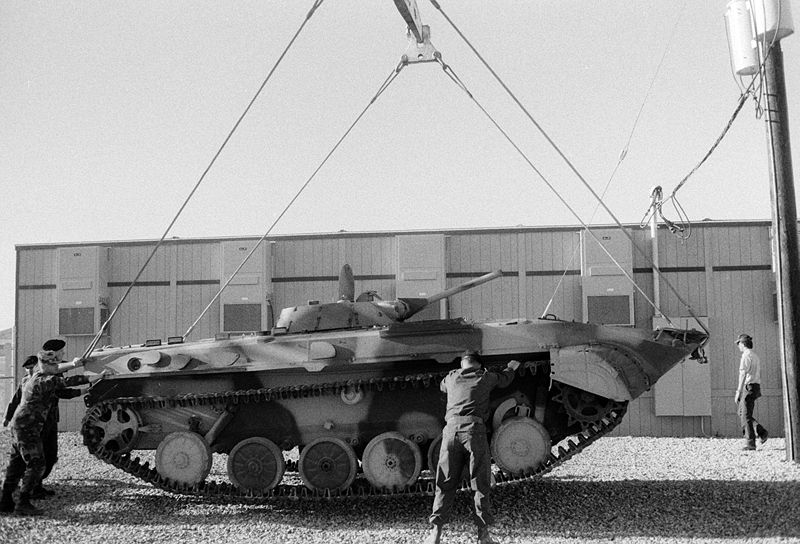

Cold War Tanks


































Cold war tanks posters

Cold War Main Battle Tanks

Cold War Soviet Army

